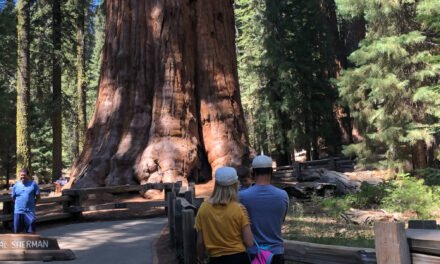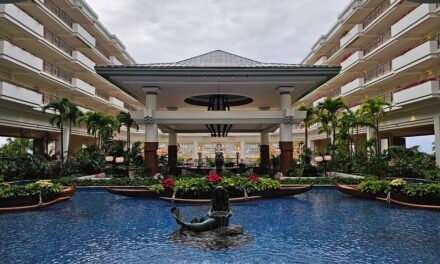
Life Changing Antarctica

Stark, cold, beautiful desolation. Since its discovery by European explorers in January 1820, the coldest, driest, iciest, windswept landmass in the Southern Hemisphere has long remained one of the most inhospitable habitats on Earth. Surrounded by jagged mountains shrouded in snow that soar more than a mile high above ice-strewn waters, Antarctica has no history of human habitation, no trees or significant plant life of any kind except for lichens, algae, and bacteria, and no native land mammals, amphibians, or reptiles. Antarctica’s frigid, oxygen-rich, ocean ecosystem supports penguin colonies, seabirds, whales, seals, fish, small zooplankton like krill, and microscopic plant-like organisms called phytoplankton, which is the base of the marine life food chain. Capped by a massive inland glacial ice sheet that is as much as 2.7 miles thick, scientists have proclaimed that the land hidden beneath the ice sheet is less well known to us than the surface of Mars. All to say, it felt somewhat surreal to be drawing a breath in the last unexplored and unspoiled continent on Earth.
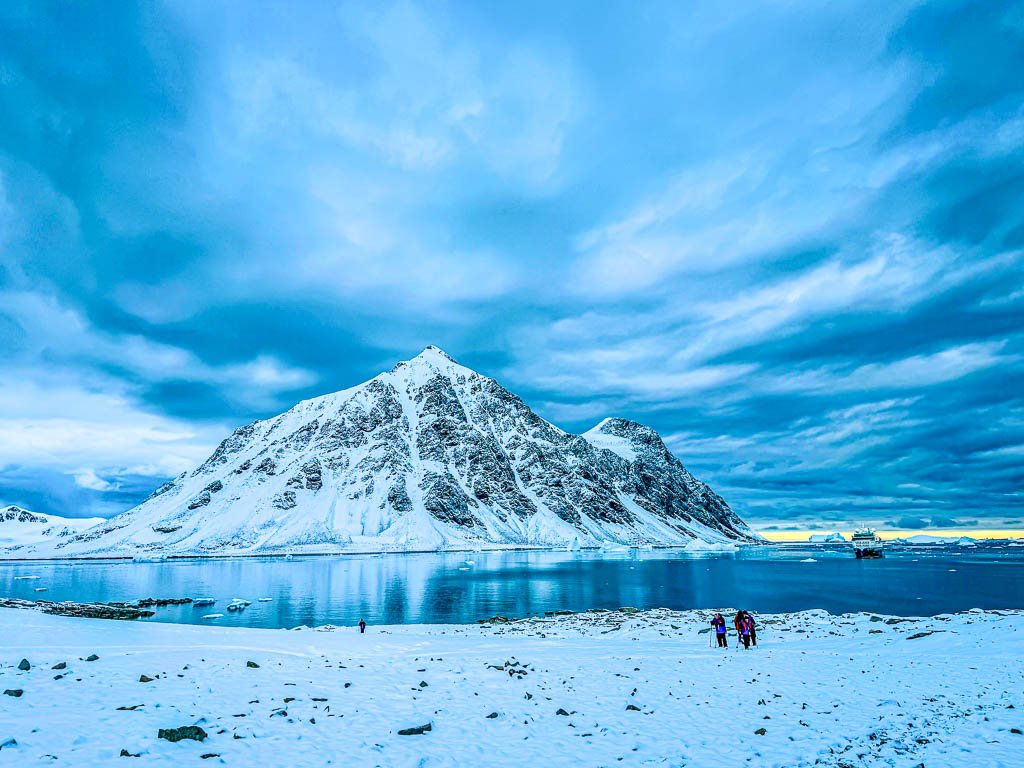
Blue morning… blue day… on the Antarctic Peninsula. Photo by Jett Britnell
THE SOUTHERN LAND NOT YET KNOWN
“Antarctica is otherworldly, like nothing I’ve ever seen before. Stark, cold, beautiful desolation.”
— Mark Hoppus Musician & Songwriter, BLINK-182
When Flemish cartographer, Abraham Ortelius, published the first modern atlas called “Theatre of the World” in 1570, he depicted a yet undiscovered Antarctica as Terra Australis Nondum Cognita which translates as “the southern land not yet known.” His map was drawn entirely from conjecture because, since time immemorial, scholars believed that a southern continent must logically exist to counterbalance the weight of the known northern hemisphere.

“Theatrum Orbis Terrarum” (Theatre of the World) published in 1570 is considered to be the world’s first true atlas. (Public Domain)
Ask just about anyone who has been to Antarctica, and they will surely proclaim it was life changing. It’s hard to describe why this feeling is so universal, but experiencing firsthand the sheer scale of one of the remotest frozen frontiers gets under your skin. Before its discovery in 1820, Antarctica had spent the last 35 million years in relative seclusion due to its lack of natural land bridges connecting it to other continents. Indeed, few humans will ever set eyes on this icy continent. To this day, nobody indefinitely lives in Antarctica in the way that they do in the rest of the world, as it has no towns or cities, no permanent residents, and no commercial industries.
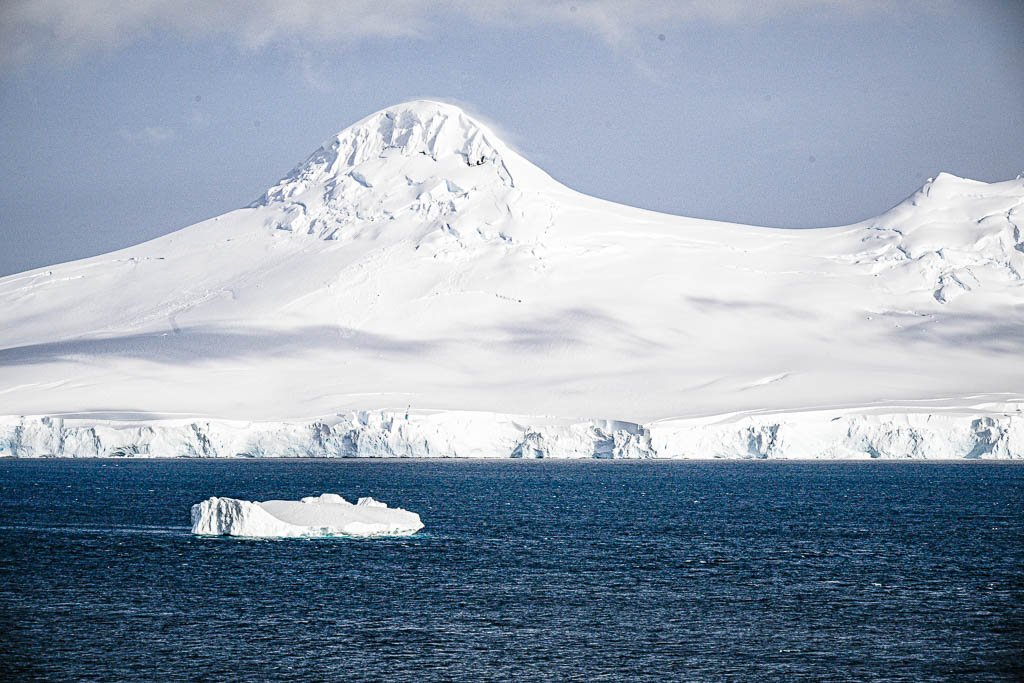
Antarctica had spent the last 35 million years in relative seclusion due to its lack of natural land bridges connecting it to other continents. Photo by Jett Britnell
If you are not employed to work at a scientific research station, the best way to visit Antarctica is from aboard a small expedition ship, as it is illegal to travel to any part of Antarctica without a permit. To do so without permission could lead to a significant fine or prison sentence. However, if you are a passenger on an organized visit via a small expedition ship, the tour operator arranges for any required permits. The reason for all the red tape is that Antarctica is protected by the Antarctic Treaty, which preserves the continent for peaceful and scientific purposes only.
THE ANTARCTIC TREATY AND IAATO
“The thing that is most beautiful about Antarctica for me is the light. It’s like no other light on Earth because the air is so free of impurities. You get drugged by it, like when you listen to one of your favorite songs. The light there is a mood-enhancing substance.”
— Jon Krakauer, American Writer, and Mountaineer
Restrictions on access to Antarctica are in place to restrict human activities and minimize negative environmental impacts on the region’s fragile ecosystems. In 1959, the International Antarctic Treaty was signed to protect the area’s biodiversity and support a peaceful scientific preserve devoid of ownership by any one nation. The treaty prohibits nuclear tests on the continent, as well as the establishment of any military bases and fortifications, conducting military maneuvers, weapons testing, mineral and oil exploration, or radioactive waste disposal. Hailed as being one of the most successful international agreements, any problematic differences concerning territorial claims have been set aside, and as a disarmament regime, it has been extremely successful.
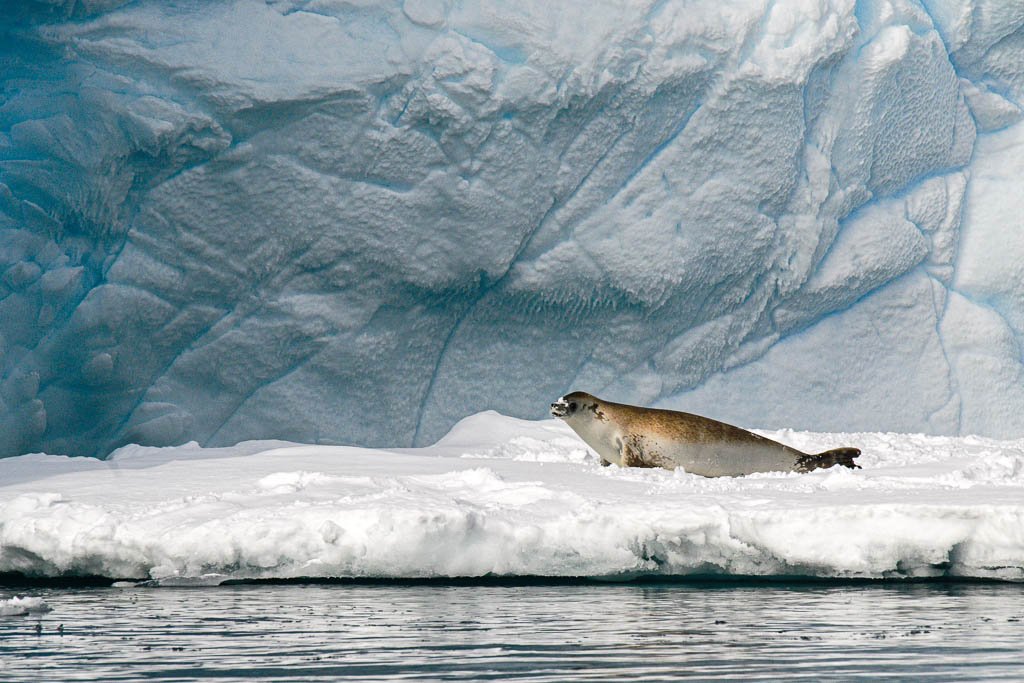
Seal on ice. Photo by Jett Britnell
Further, in 1991, seven independent travel companies that operate in Antarctica established IAATO, the International Association of Antarctica Tour Operators. Its mandate is to self-regulate and promote best practices in the field by ensuring safe, responsible, and environmentally sensitive tourism within Antarctica’s fragile ecosystem. IAATO appears to be working as their members work cooperatively to ensure shore landings are subject to “stringent restrictions on landing activities of time and place.” We also never saw another expedition ship during our voyage, as the tour operators also communicated their itineraries to each other to ensure two vessels did not show up in the same vicinity.
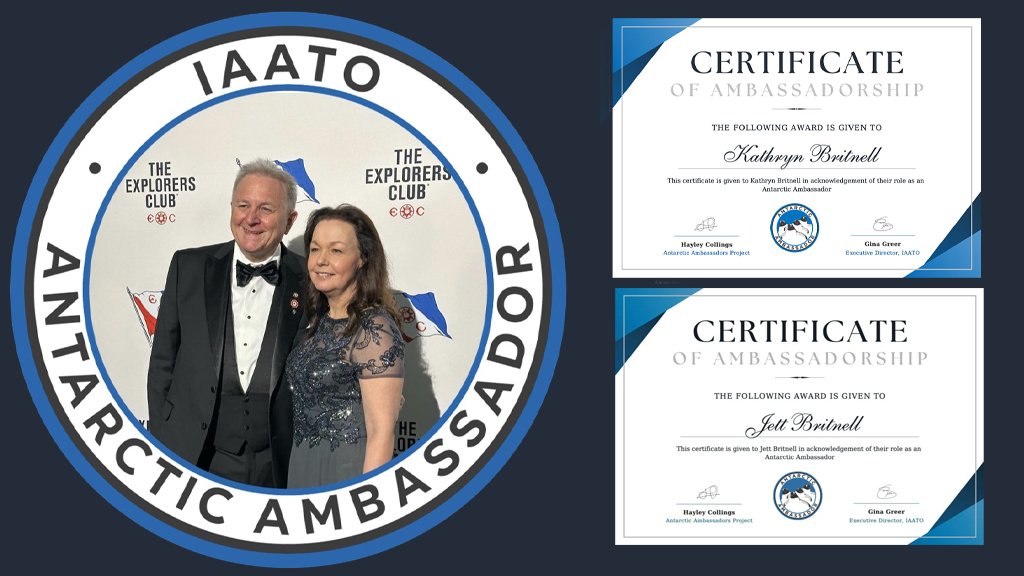
We were both named IAATO Antarctic Ambassadors in 2023
IAATO has also created a global Antarctic Ambassador program that represents a collaboration of visitors to the region, school students, polar scientists, field staff, and youth groups who care about Antarctica & protecting its unique landscape. In IAATO’s own words, “It’s our belief that Antarctic expeditions with responsible and robust environmental practices at their core create among visitors a greater understanding of the environment, Antarctica’s value to global science, and how changes to the region can impact us all. This is why responsible travel can create Antarctic Ambassadors.” You can learn more about the program here: https://iaato.org/antarctic-ambassadors
SMALL SHIP EXPEDITIONS IN THE CONTINENT OF SCIENCE
“We believe that small ship expeditions are the way forward, with a smaller number of passengers, led by experts and operating with the utmost respect for the environment.”
—Hayley Peacock-Gower, Chief Marketing Officer, Aurora Expeditions

The Sylvia Earle held in position near Stonington Island using its virtual anchor. Photo by Jett Britnell
Aurora Expeditions’ state-of-the-art ship, the Sylvia Earle is named after renowned marine biologist, oceanographer, explorer, author, and lecturer, Dr. Sylvia Earle. Designed to handle the rigorous demands of polar expedition cruising, this purpose-built, ice-strengthened, ship is equipped with an innovative ULSTEIN X-BOW® inverted bow design that efficiently slices through ocean swells, so passengers will feel fewer vibrations and greater comfort during ocean crossings. The ship is also one of the lowest polluting ships in the world due to its streamlined bow design, which generates high fuel efficiency and lowers fuel emissions by 80%. Sylvia Earle’s GPS and steering technology allow it to ditch the traditional ship’s anchor, which is known to damage the sea floor and rely solely on a virtual anchor to keep the ship in position.
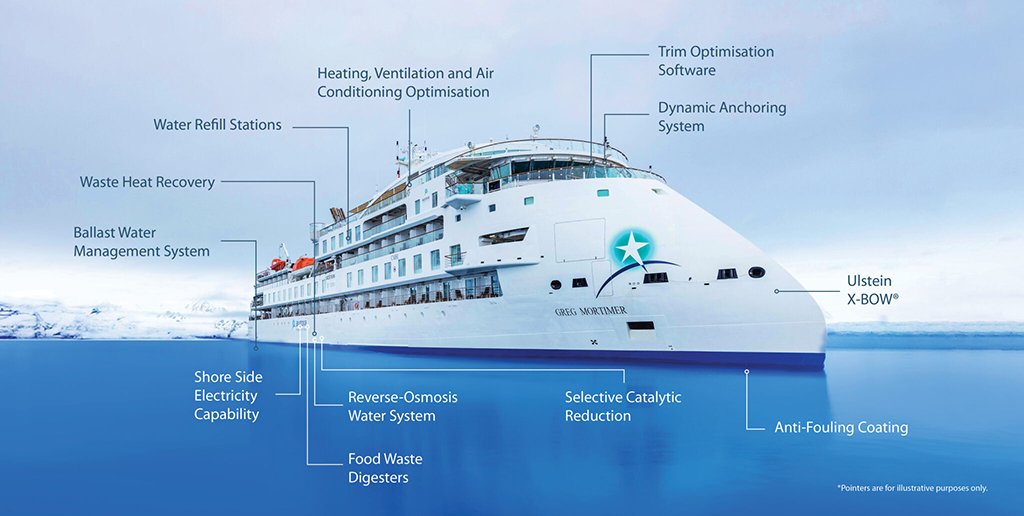
This is an image of the Greg-Mortimer expedition ship. Its sustainability features apply to both the Greg Mortimer and the Sylvia Earle expedition ship. (illustration by Aurora Expeditions)
Small ship expedition cruises differ from traditional cruise ships in multiple ways. Primarily, expedition ships are smaller and specifically designed to explore harder-to-reach places inaccessible to larger vessels. Guests must also be prepared for ad hoc changes in the planned itinerary due to changing weather, sea conditions, or landing sites that may be abruptly closed.
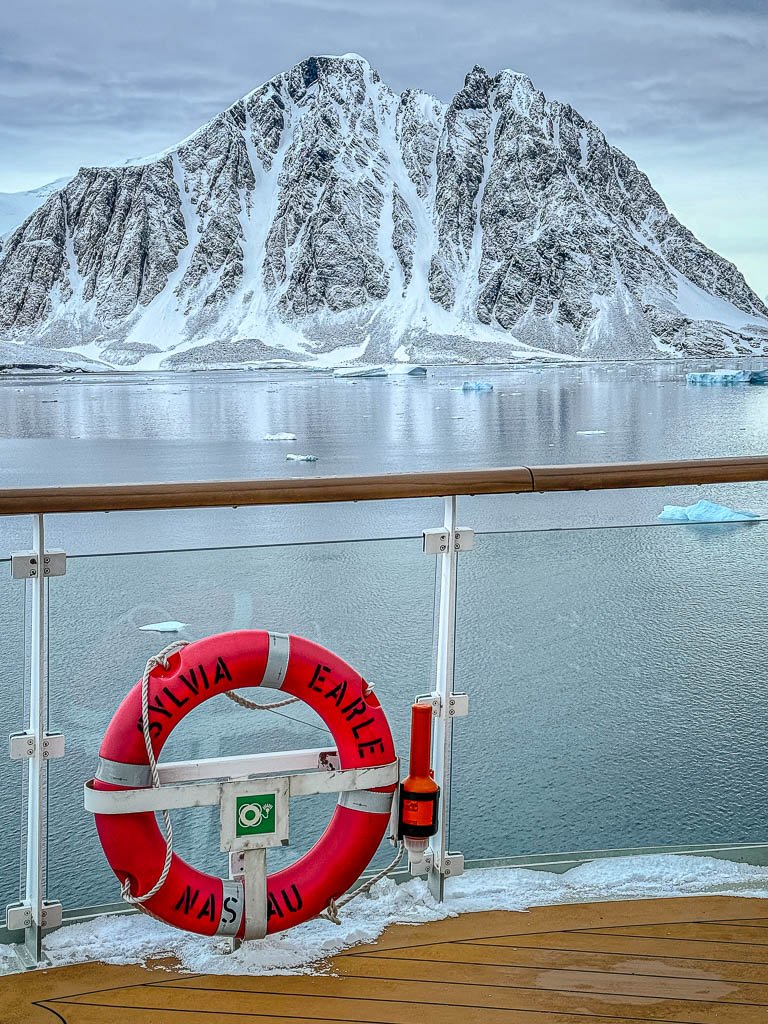
The passing views from the ship’s outdoor observation deck are downright breathtaking. Photo by Jett Britnell
Onboard, it’s also vastly different insofar as guests who book excursions aboard expedition ships are focused on immersive outdoor experiences, exploring remote places, and studying the fauna and flora. Hence, you won’t ever see an eye-popping light show or a glitzy casino on the Sylvia Earle.

Sylvia Earle’s library. Photo by Jett Britnell

Science lab lounge. Photo by Kathryn Britnell
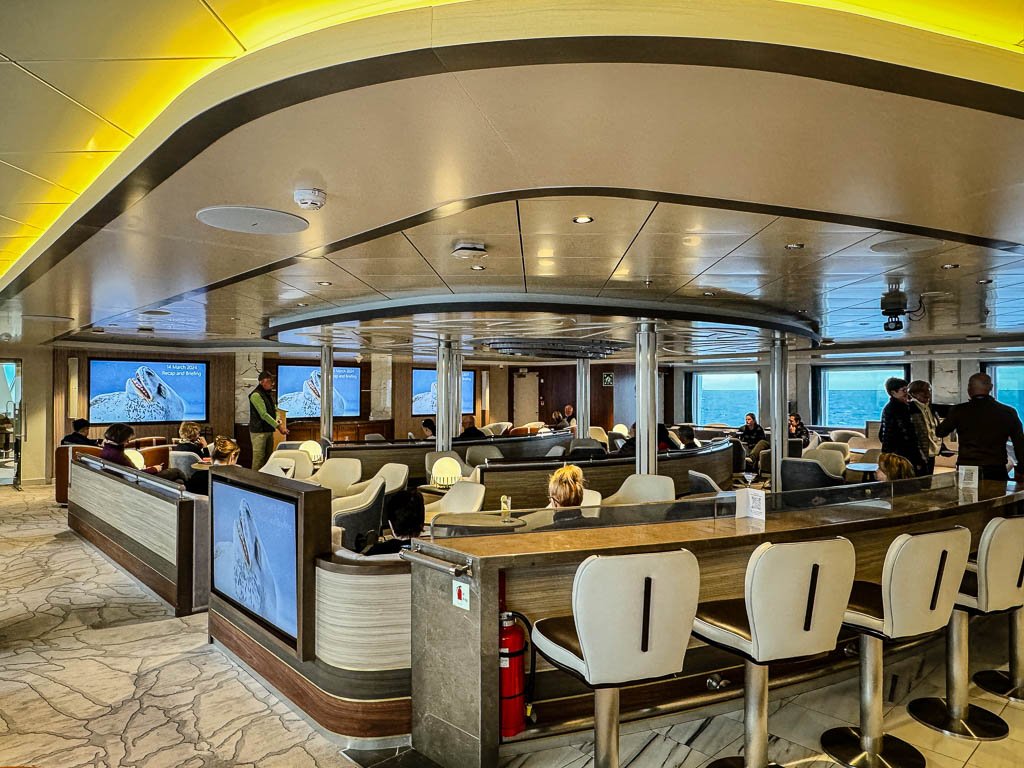
State of the art lecture theater. Photo by Jett Britnell

Stateroom cabin with complementary expedition jackets. Photo by Jett Britnell
What you will find is a ship built for speedy disembarkation via Zodiacs through four different doorways. An enormously large mudroom with access to lockers and drying racks as well as a staging area for boarding the Zodiacs. Onboard amenities include numerous creature comforts, including picturesque views through the glass floor-to-ceiling windows in the atrium lounge. In the ship’s common areas, there is plenty of open space with seating for guests to relax, order a drink from the Tektite Bar, the library, a state-of-the-art lecture theater, and an expansive upper deck observation lounge that performs double duty as social gathering areas. The ship also boasts two Jacuzzis, a sauna, and an exercise room. Most of the 74 ensuite staterooms have balconies with large floor-to-ceiling windows, and each cabin includes a 42’’ flat-screen TV, a room-controlled thermostat, ample closet space, and a telephone for ordering room service or speaking to other departments on the ship.

A Zodiac headed out for a shore landing is dwarfed by Antarctica’s massive ice sheet. Photo by Kathryn Britnell
It’s worth noting that shore landings in Antarctica are restricted to 100 people ashore at any one time. Hence, larger cruise ships with 200 or more passengers must stagger their landing parties. Vessels transporting more than 500 passengers onboard are not allowed to land passengers in Antarctic waters. Smaller expedition ships like the Sylvia Earle can hit the sweet spot with an average of 100 passengers on Antarctic expeditions.
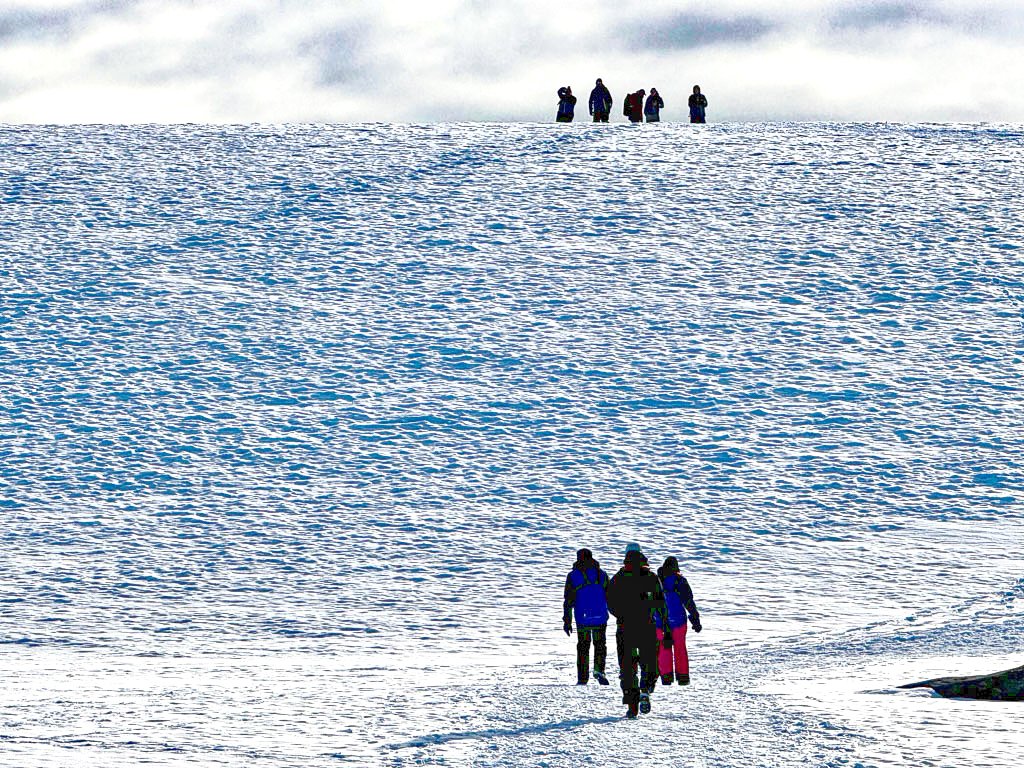
Expeditioners roaming the small flat peninsula on Winter Island which is part of the Argentine Islands and composed entirely of igneous rocks. Photo by Jett Britnell
CROSSING THE DRAKE PASSAGE
“This, then, was the Drake Passage, the most dreaded bit of ocean on the globe—and rightly so.”
— Alfred Lansing, Author, Endurance: Shackleton’s Incredible Voyage
Long considered one of the most treacherous voyages for any ship to navigate, the expansive stretch of ocean separating the southern tip of South America from Antarctica has earned its grisly reputation. At any time of year, the wave action and weather conditions in the Drake Passage are unpredictable. Hence, the mere thought of crossing the Drake can be intimidating for passengers departing from Ushuaia, Argentina, aboard a ship bound for Antarctica.
People who have experienced the notorious open sea crossing to the ice-bound edge of the world with no land in sight for two days will tell you the Drake Passage has two states. The snarly “Drake Shake” can be infamously nerve-rattling when it slams large, heaving waves as high as 40 feet (12 meters) against a ship’s hull, whereas the “Drake Lake” by comparison delivers a relatively calm, non-stomach-churning experience.
Today’s modern small expedition ships, such as the MV Sylvia Earle are sturdily equipped with nautical stabilizing technology, advanced navigational aids, and sophisticated maritime weather forecasting that help the ship’s captain avoid extreme weather or chart a more optimal course, thus making the notorious “Drake Shake” less of an issue. Hence, many Antarctic-bound cruise passengers never encounter the Drake Passage’s infamously big waves but more often experience the “Drake Lake.”
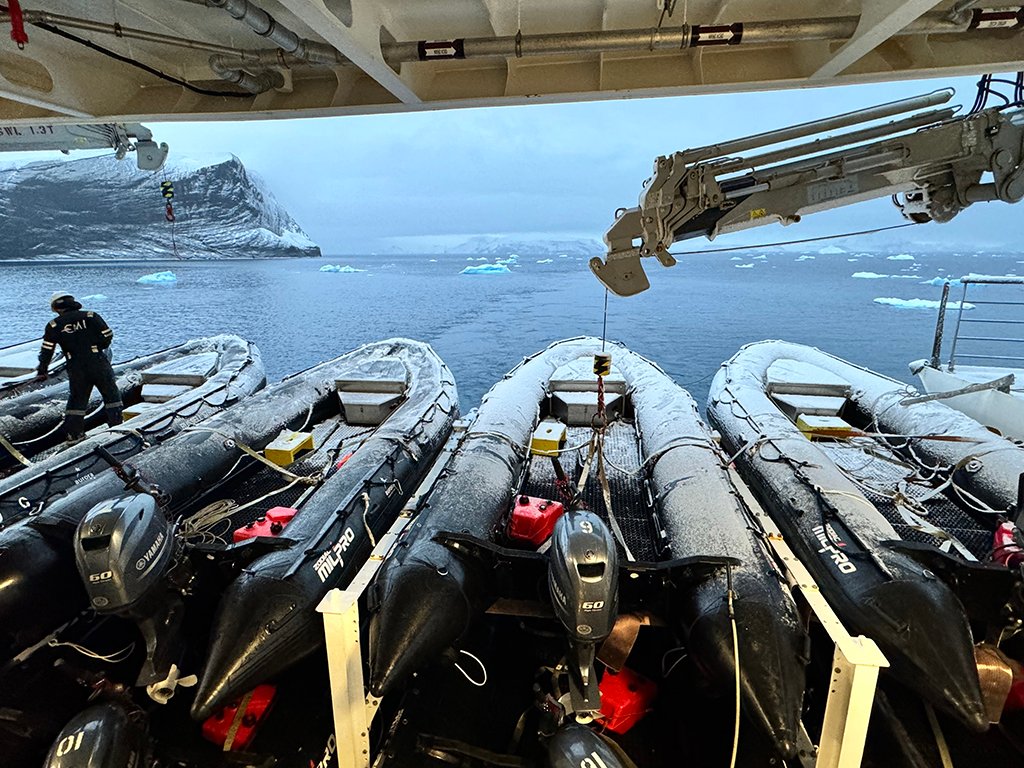
On an expedition ship work is always happening behind the scenes. If it snows overnight, there are crew members who are up early prepping the Zodiacs for the days adventures. Photo by Jett Britnell
AURORA’S EXPEDITION TEAM & SHIP’S CREW
“I love to push the envelope on each of Aurora’s expeditions and try to include at least one new site or landing – including for myself, the expedition team or even the captain. As they say on expeditions, our itineraries are flexible and allow for new and unexpected encounters all the time, and plans can change very quickly. Variety is the spice of life!”
— Ashley Perrin, Expedition Leader, Aurora Expeditions

Ashley Perrin, Expedition Leader, giving a trip status update presentation in the ship’s lecture theater. Photo by Jett Britnell
Firstly, we cannot say enough good things about the ship’s crew. The word exceptional springs to mind. Within a day or two after boarding the ship, we were greeted by name by all the servers and stewards onboard. Highly personable, warm, and friendly. On all levels, everyone seemed to go above and beyond.

Highly personable, warm, and friendly. Photo by Jett Britnell
This level of professionalism also extends to Aurora’s expedition team, which is comprised of seasoned polar experts, geologists, glaciologists, historians, naturalists, photographers, mountaineers, scuba diving masters, sea kayakers, and marine biologists who are keen to share their knowledge and passion for Antarctica’s fauna and flora. Throughout the cruise, the main form of entertainment was lectures by the expedition team members, who took guests on a deeper level of understanding about Antarctica’s history, culture, biology, and the impactful effects climate change is having on the region. Informal educational discussions are also carried out while on shore or in the Zodiacs.
While the expedition guides are always standing by to ensure guests maintain a safe distance from wildlife, at some shore landings we were allowed to roam freely rather than follow a prescribed route. Aurora Expeditions also offers a range of optional activities led by expert guides, including paddling, stand up paddle boarding, sea kayaking, scuba diving, polar snorkelling, climbing, alpine trekking, and ski touring, to name a few. The expedition team must assess the conditions at each shore landing before putting anyone ashore.

Dive Master, Darren Clarke, steers the Zodiac into position for the onboard scuba diving guests to make a polar dive. Photo by Jett Britnell
Our expedition leader, Ashley Perrin, said every voyage to Antarctica is uniquely different due to the route being largely determined by changing weather and ice conditions. In all, our voyage logged 2,765 nautical miles. True to our expedition leader’s word, we charted ten new nautical miles along the way and logged several new shore landing sites during our expedition.

Weddell Sea & Across the Antarctic Circle itinerary March 8th to 25th 2024
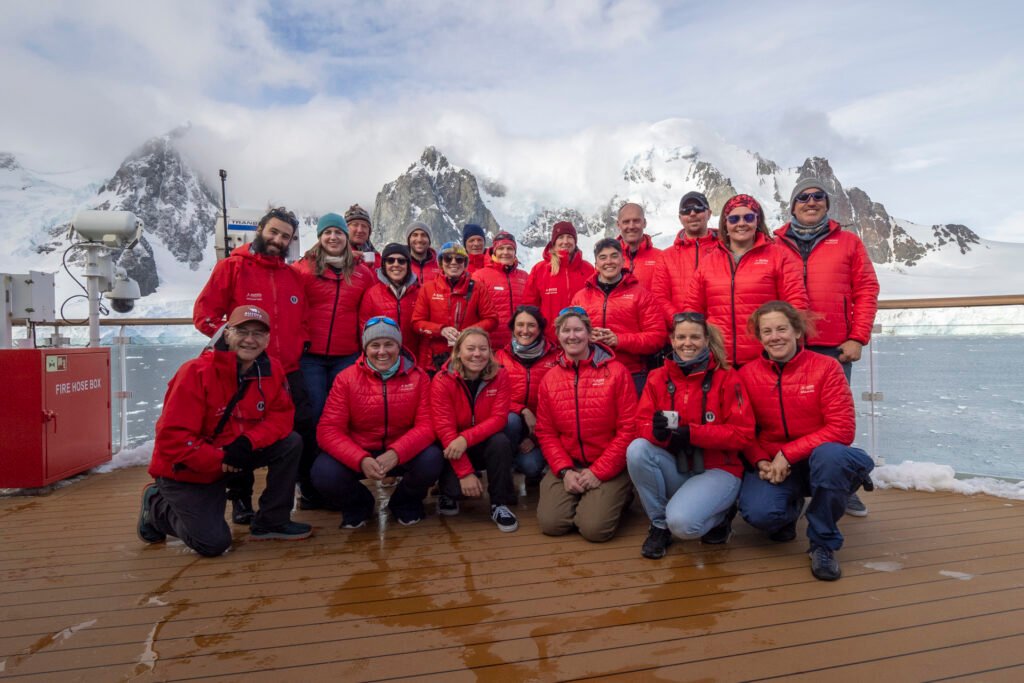
Sylvia Earle’s Antarctic Expedition Team. Photo by Scott Portelli
ICEBERG ARMADAS
“The tranquility of the water heightened the superb effects of this glacial world. Majestic tabular bergs whose crevices exhaled a vaporous azure; lofty spires, radiant turrets, and splendid castles; honeycombed masses illumined by pale green light within whose fairy labyrinths the water washed and gurgled.”
—Douglas Mawson, Australian Geologist, Antarctic Explorer
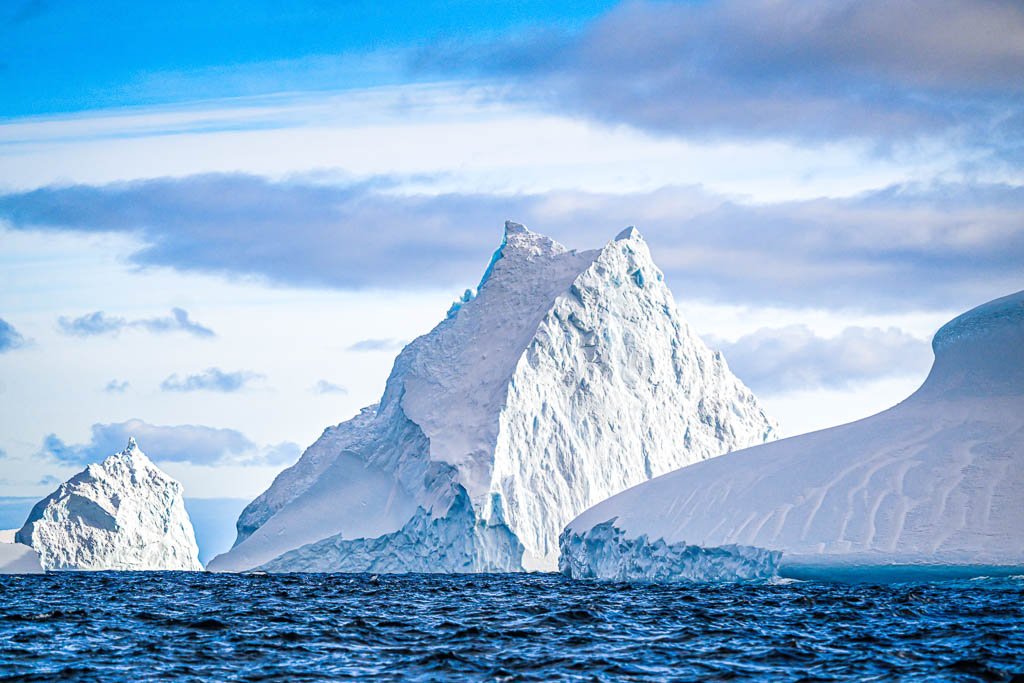
Non-tabular icebergs have different shapes, with spires and domes. Photo by Jett Britnell
Chiselled by wind and eroded by the great Southern Ocean, Antarctica’s perilous iceberg armadas were found to be mesmerizing. Many were massive and far more imposing than we ever imagined. Amazing sculptural shapes are “born” in a process called “calving” when they break off from the coastal edge of either tidewater glaciers or ice shelves. Virtually all icebergs in the Southern Hemisphere calve from Antarctica’s continent.
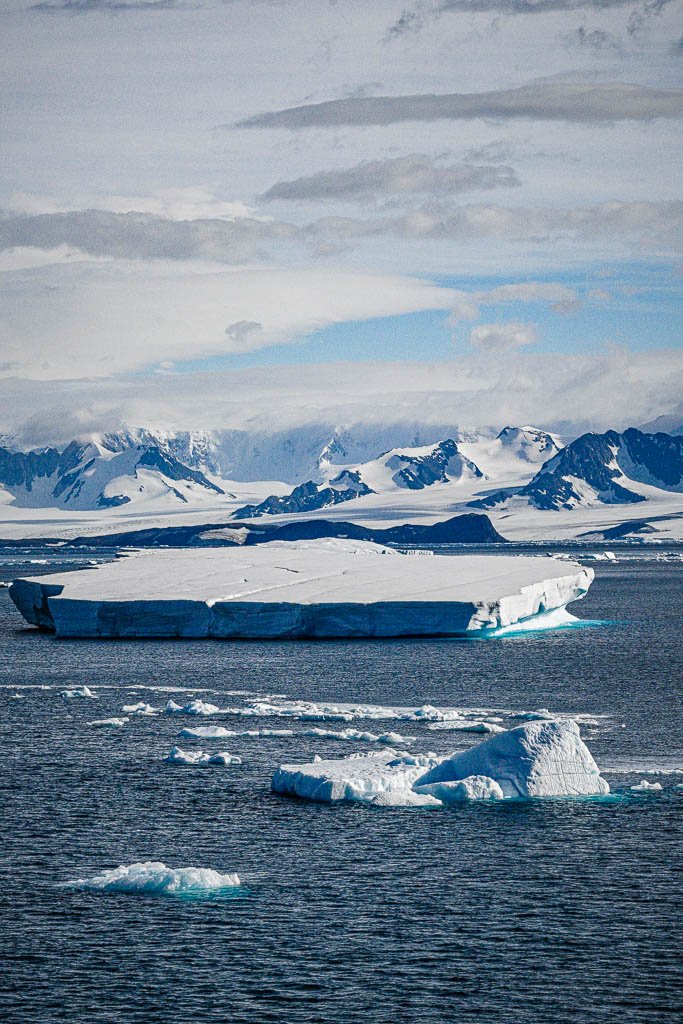
Tabular icebergs have steep sides and a flat table top. Photo by Jett Britnell
Typically, icebergs are divided into two main types, tabular and non-tabular. Tabular icebergs, also called ice shelf icebergs, present a flat plateau top with steep sides, whereas non-tabular icebergs assume different irregular shapes that are variously described as having pyramid-like tips, blocks, domes, wedges, sloping sides, and spires. Icebergs appear to be floating everywhere in some places, and yet you may see hardly any in other spots.
An iceberg named B-15, deemed to be the world’s biggest recorded iceberg, calved from Antarctica’s Ross Ice Shelf in late March 2000. Reliably assessed by NASA using satellite imagery, B-15 measured approximately 186 miles long by 25 miles wide with a surface area of 4,250 square miles. Scientists estimate an iceberg’s lifespan from the first glacial snowfall to when it completely melts into the sea is as long as 3,000 years.
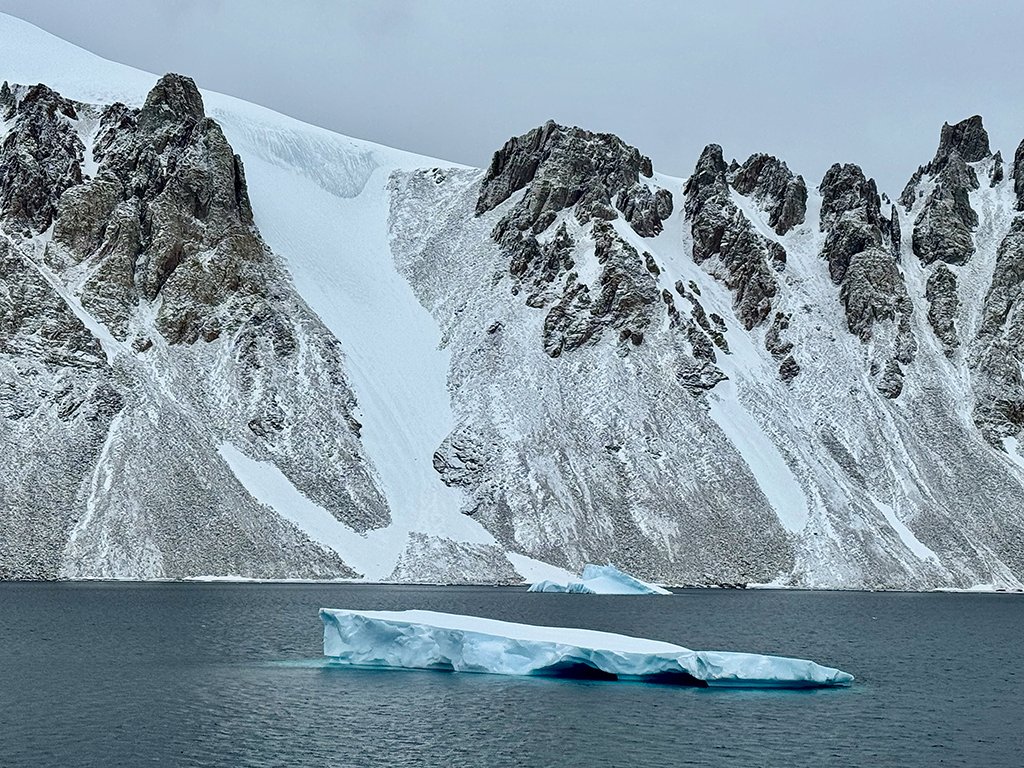
Not far from Horseshoe Island which sits in Square Bay, off the coast of Graham Land in Marguerite Bay, well to the south of the Antarctic Circle. Photo by Jett Britnell.
WILDLIFE IN A FROZEN REALM
“The answer to every problem involved penguins.”
—Rick Riordan, American Author
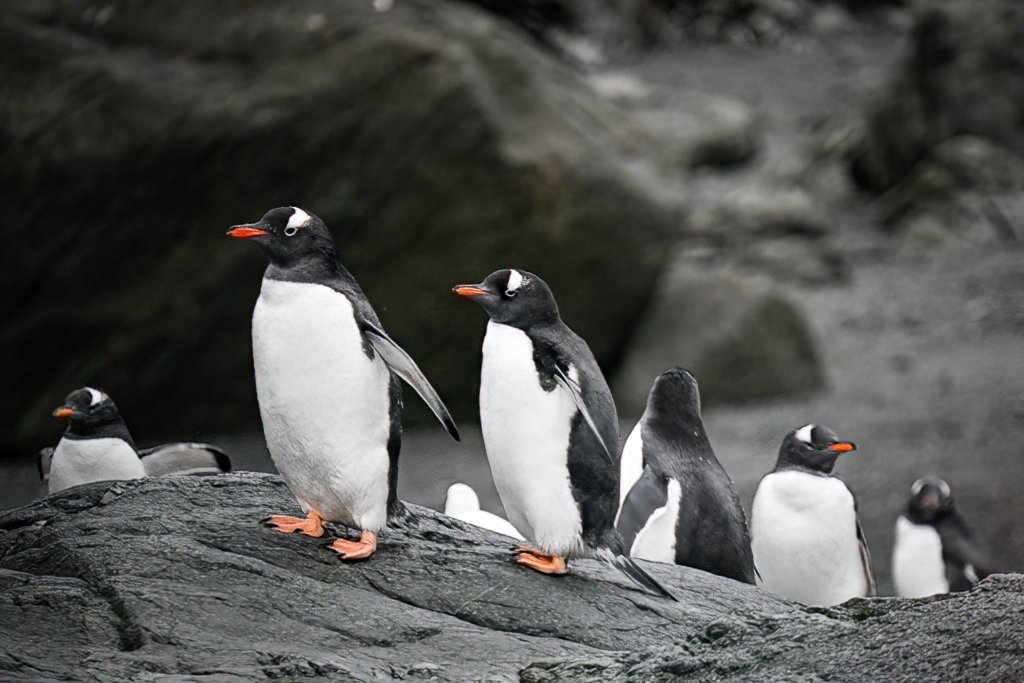
Gentoo penguins are closely related to Adélie and Chinstrap penguins but have distinctive orange-red bills and feet. They are the third largest penguin, following the emperor and king. Photo by Jett Britnell
Since Antarctica’s vast ice sheet center is particularly hostile to all life forms, most wildlife is concentrated in coastal areas. One could ask, “How could any living thing survive in the driest, coldest, and darkest places on earth?” The truth is, it is Antarctica’s surrounding Southern Ocean and not the land that is teeming with an abundance of penguins, whales, penguins, seals, and seabirds.

Orca (or Killer Whale) prey on fish, squid, penguins, seals, dolphins, porpoises, and even other whales. Photo by Jett Britnell
Penguins are by far the star attraction here. Colonizing the sea around this great white continent are four different species, the Adéle, the Chinstrap, the Gentoo, and the supremely iconic Emperor penguin. Penguins congregate in vast numbers to form large colonies and use Antarctica as their breeding ground. Like most Antarctic wildlife, penguins are completely unafraid of humans.
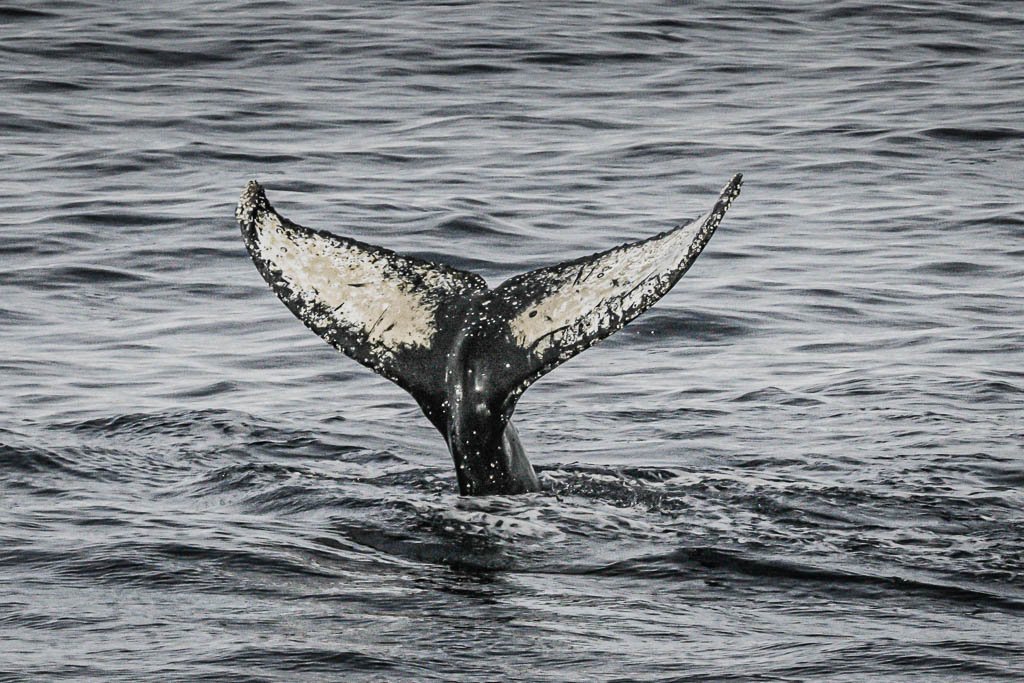
Humpback whales are the most abundant baleen whale in the nearshore waters around the Antarctic Peninsula. Photo by Jett Britnell.
The great white continent is also home to eight species of whales; humpback, minke, sperm, blue, sei, fin, southern right whale, and orcas, who migrate here to feed on the large numbers of krill, a chief food source for baleen whales. Orcas are carnivores who will venture deep into the coastal pack ice to prey on penguins, seals, squid, and whales. While baleen whales will migrate to warmer waters to breed, orcas are the only whale species that breed in Antarctic seas, as small calves have been observed in mid-winter.
Among the seals to be seen here is the imposingly large leopard seal. Notoriously fierce predators, leopard seals ruthlessly hunt penguins by floating in water near land or the edge of ice floes where penguins congregate. Weddell seals can remain underwater for up to an hour. In winter, they will dive beneath the ice and use their sharp teeth to poke breathing holes in the ice. Apart from orcas, seals have no natural predators here, hence, they appear unconcerned by the presence of humans. Antarctic Fur Seals, Ross Seals, and Crabeater seals, after humans, are the most numerous large mammals in the world, with a population that’s roughly estimated to be in the range of 15 million.

Fur seal by Kathryn Britnell

Fur seal by Kathryn Britnell

An Antarctic Fur seal strikes the pose. Photos by Kathryn Britnell
Antarctica is also one of the world’s top birdwatching hot spots, with a vast variety of both native and non-native species. While penguins and albatrosses may seem to garner all the press, there are 35 species of seabirds, such as petrels, skuas, prions, fulmars, shearwaters, terns, and two species of cormorant inhabiting the region that play an important role in the marine ecosystem. Space is limited for the 19 bird species that establish nesting grounds here, as it’s estimated that 100 million or more seabirds breed along the coastal areas and offshore islands of Antarctica.
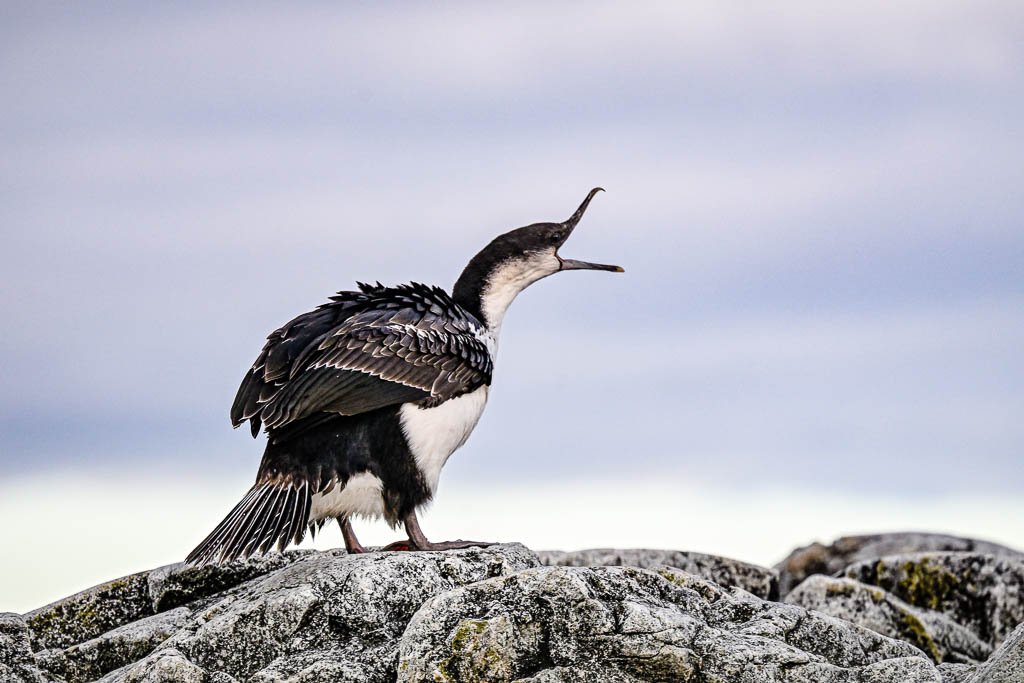
The Imperial Cormorant, aka Antarctic Shag, is the only cormorant species found on the Antarctic Peninsula, South Shetland Island, and Elephant Island. Photo by Jett Britnell
AN EXPLORATORY FORAY INTO THE WEDDELL SEA
“Adventures to the Weddell Sea feel more exploratory and adventurous than other Antarctic expeditions – because they are. Fewer vessels travel to this region, in part because entrance into the Weddell Sea cannot be assured, but also because there are fewer landing options in the Weddell Sea compared to the more heavily visited Gerlache Strait area on the west side of the Antarctic Peninsula.”
—Roger Kirkwood, Expedition Leader, Naturalist & Polar Expert

“The worst sea in the world.” — Sir Earnest Shackleton. Photo by Jett Britnell
Lying east of the Antarctic Peninsula and covered in notoriously thick sea ice year-round, the Weddell Sea is legendary for its enormous tabular icebergs. Only the northwestern region is visited by ships when conditions are optimal between January and March. Even during these months, there are no guarantees that poor weather or impenetrable sea ice will compel an expedition ship’s captain to turn back. Historian Thomas R. Henry wrote in his 1950 book The White Continent, “The Weddell Sea is, according to the testimony of all who have sailed through its berg-filled waters, the most treacherous and dismal region on Earth. Sir Earnest Shackleton plainly stated it was… “The worst sea in the world.”
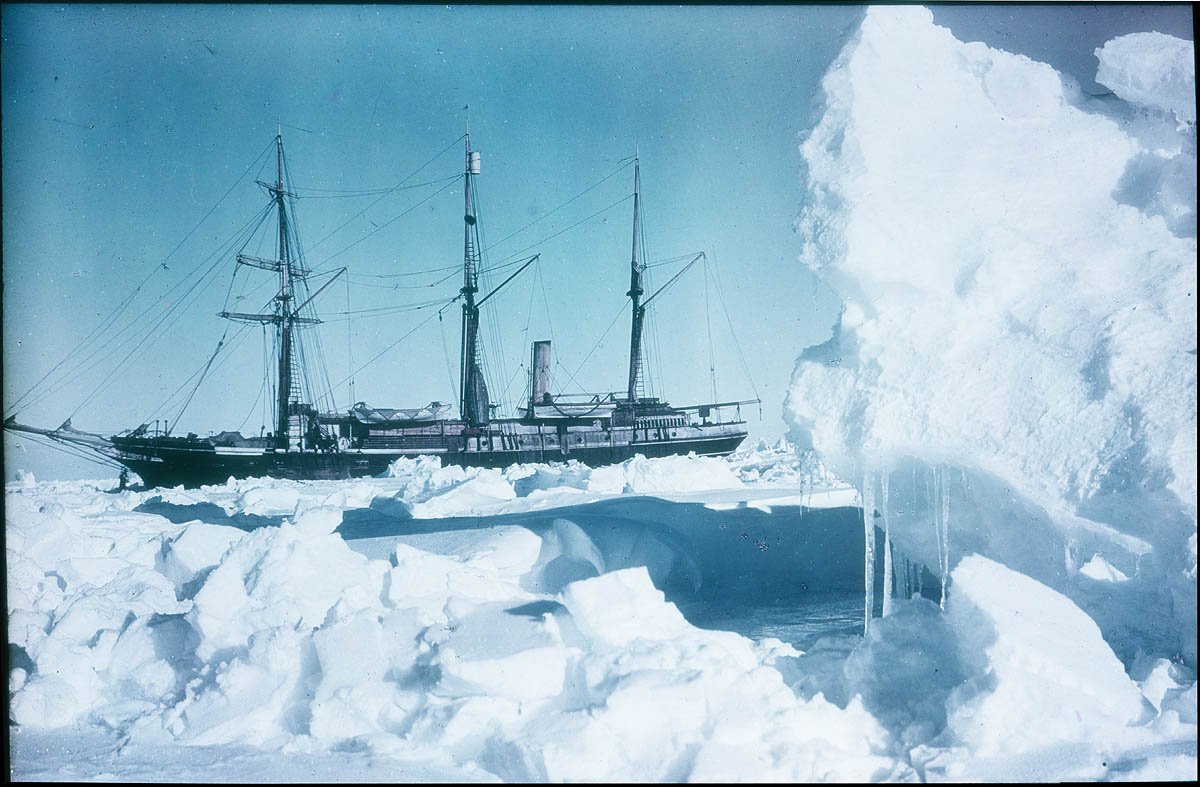
Shackleton’s ship Endurance beset in pack ice and slowly being crushed
The Weddell Sea is famously linked to Shackleton’s ambitious Imperial Trans-Antarctic Expedition of 1914–1917 to make the first land crossing of the Antarctic continent. Unfortunately, by January 19, 1915, Shackleton’s ship Endurance, a 144-foot, three-masted wooden ship, was beset in pack ice and slowly being crushed. It would never sail again as the vessel incurred major damage to its hull and sank on November 21, 1915. On Saturday, March 5th, 2022, exactly one hundred years after Shackleton’s death, scientists, and researchers aboard the SA Agulhas II using deep-water submersibles discovered the century-old shipwreck resting at a depth of 9,842 feet on the bottom of the Weddell Sea.

Devoid of any vegetation, the arid rock-strewn landscape at The Naze is a veritable gold mine of clam fossils and ammonites. Photo by Jett Britnell
One of our early shore excursions was at The Naze, a peninsula on James Ross Island. Here, we were cut loose to freely roam along the barren shoreline. There was no snow on the ground. The landscape was colored tan and rust with sloping hills and flat land peppered with rocks and stones left behind from receding glaciers. The Naze is rich in fossils from the Jurassic period, so it felt a little like we were walking upon a lunar landscape.

Shore landing at The Naze Peninsula
Another highlight was our visit to Snow Hill Island. Only a handful of people have ever set foot here because heavy pack ice will often block ships from even getting close. Snow Hill is geologically important as many marine fossils are embedded in its rocks.

During shore landings guests are not allowed to put anything on the ground. By sliding the shoulder straps off and using the waist belt to rotate the pack in front of you, the pack will rest in a horizontal, tabletop-like position. This feature enables Kathryn to quickly access her gear without having to remove the pack.
Snow Hill Hut is an abandoned wooden hut built in 1902 to house the 1901 Swedish expedition team, which spent three winters here. Today, it’s a designated historic monument. The hut is a 20-foot by 26-foot wooden building and is akin to a time capsule from a bygone era. Preserved in remarkable condition by the Antarctic cold, the contents of Snow Hill Hut were everyday items left behind when the hut was vacated.
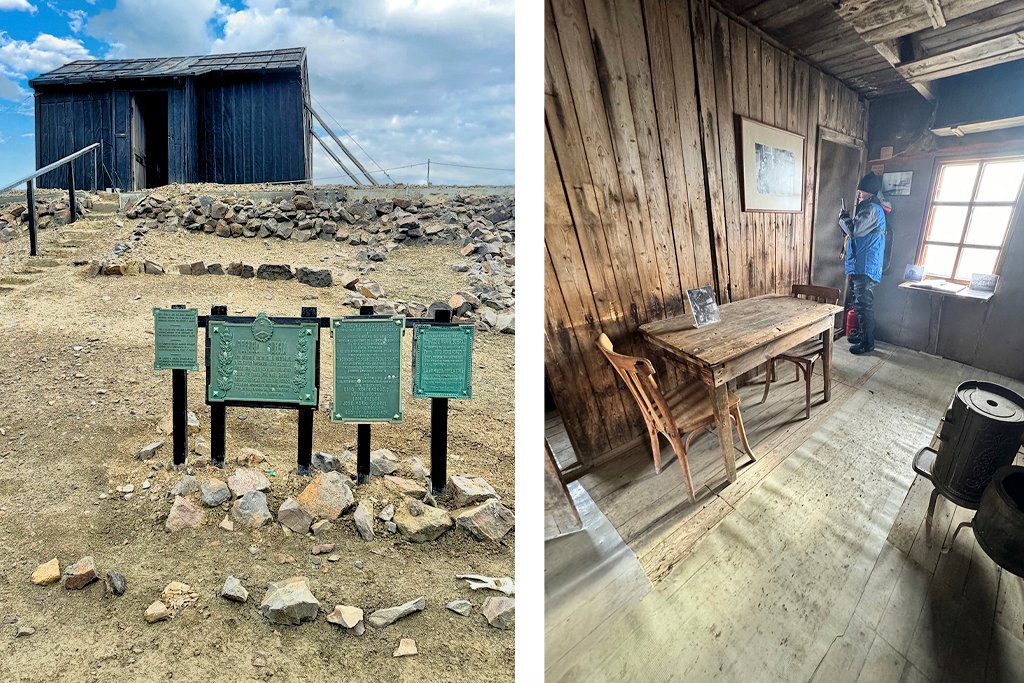
The Swedish South Polar Expedition’s (1901–1903) prefabricated black-walled Nordenskjöld hut on Snow Hill Island is the Antarctic Peninsula’s oldest remaining building and is today a protected historic site. Photos by Jett Britnell.
POSTCARDS FROM THE ANTARCTIC PENINSULA
“Like living in a postcard for two weeks!”
— Angela Smith, Marine Conservationist, Founder Shark Team One
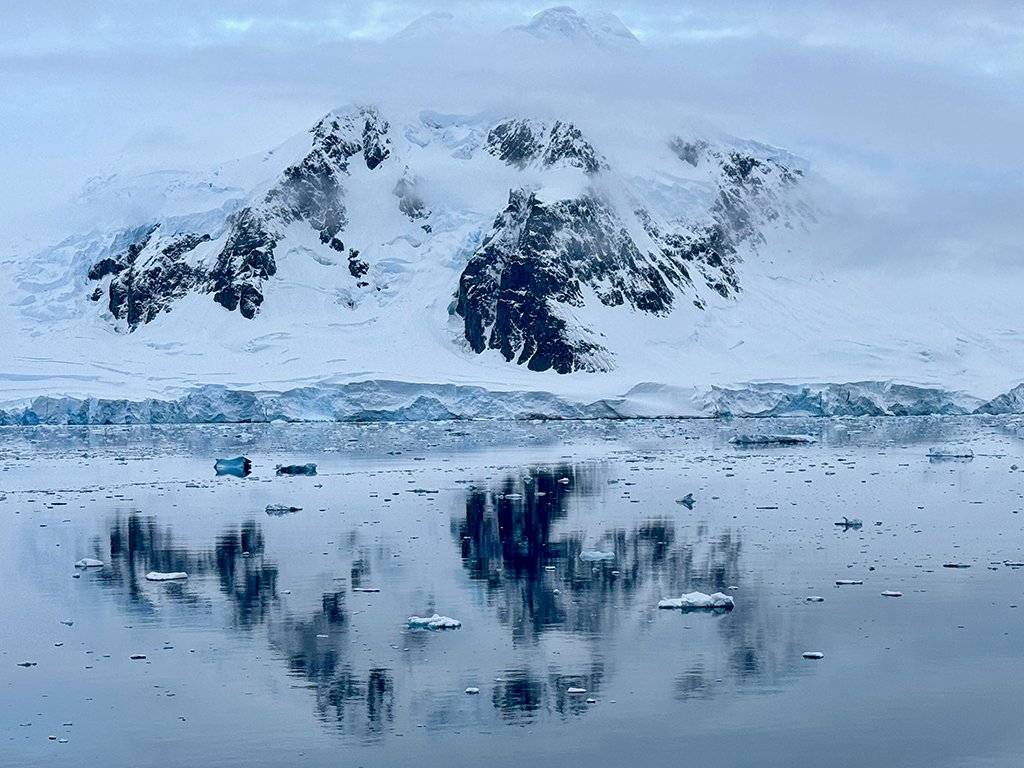
The Antarctic Peninsula has an entirely different vibe than the Weddell Sea. Photo by Jett Britnell
All along the peninsula, massive, towering, sculpted, icebergs seemed to endlessly drift past our cabin’s balcony. It was mesmerizing and felt as if we were indeed living in a postcard. It never got old reaching for our Nikon cameras to shoot away. This is the part of Antarctica that everyone experiences when they come here. It had an entirely different vibe than the Weddell Sea.
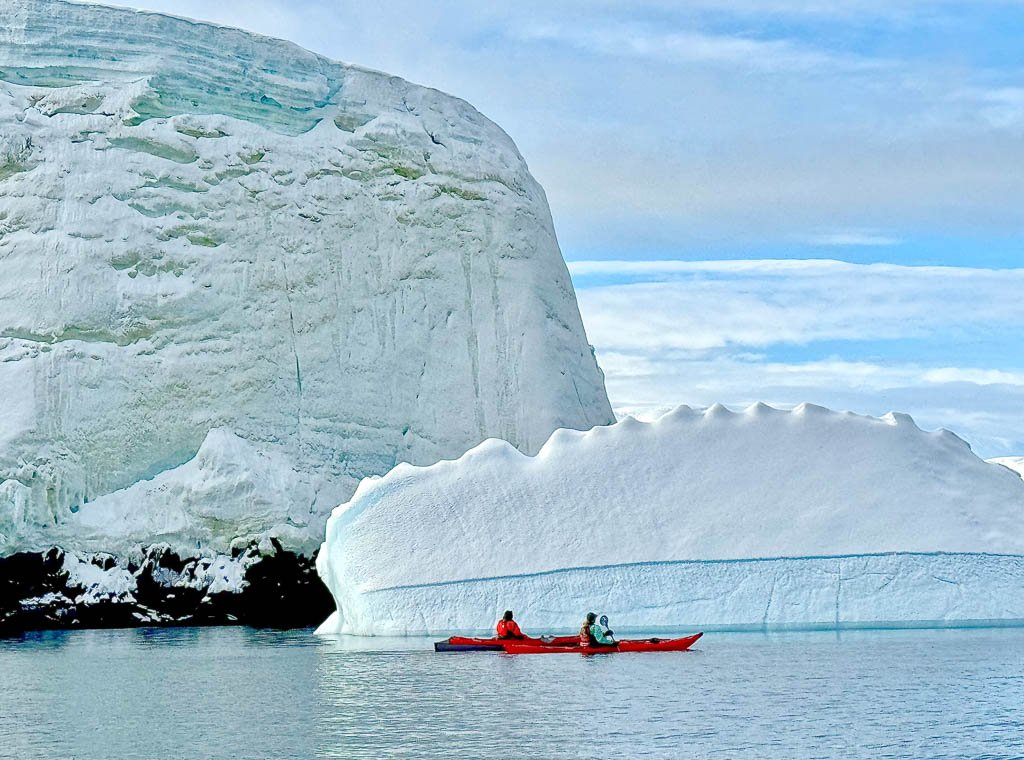
Nicknamed Iceberg Alley,the Antarctic Peninsula is a sight to behold. Photo by Jett Britnell
The Antarctic Peninsula is a narrow 800-mile spit of land that juts northward from west Antarctica’s heavily glaciated coastline. Characterized by steep, jagged mountain ranges bordered by snow-covered glaciers that calve icebergs into the sea, the peninsula is a staggeringly beautiful stretch of Antarctica. Apart from being the most accessible place for visitors to Antarctica, it’s also lauded for its abundant wildlife.
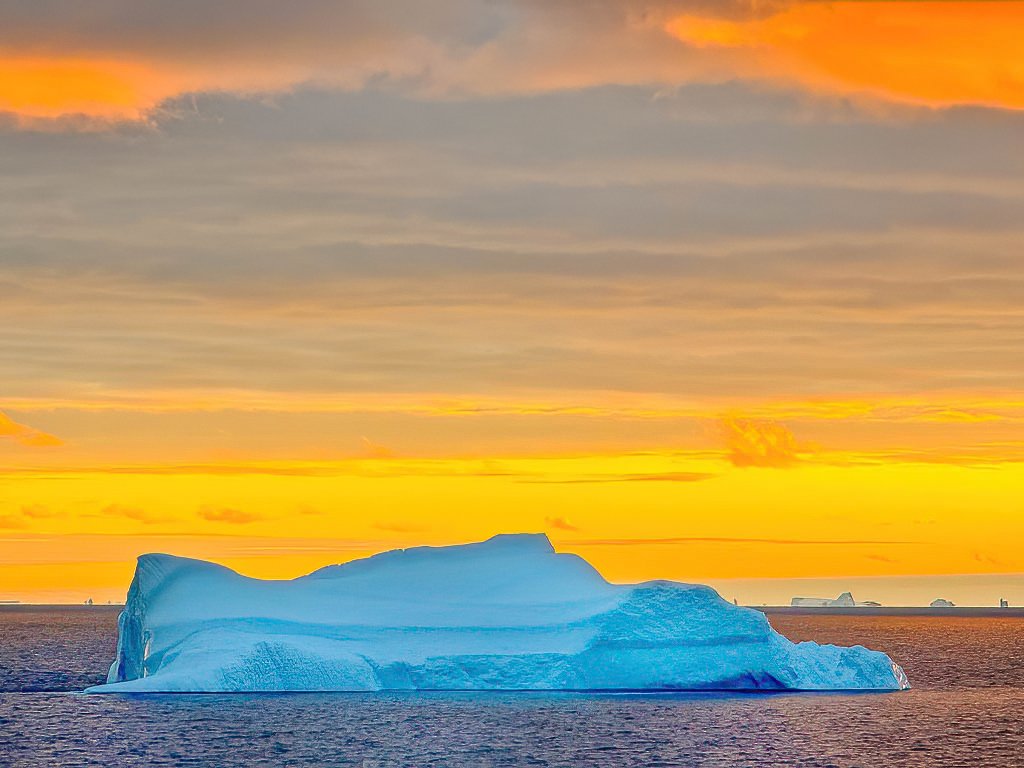
Surprisingly, we witnessed a few tropical-worthy sunsets in the Southern Ocean. Photo by Jett Britnell
Cruising down Lemaire Channel’s convoluted passage, which runs between the Antarctic Peninsula and Booth Island, felt other-worldly. With sheer cliffs on every side, the picturesque scenery was visually stunning. The occasional humpback whale or crabeater seal could be seen foraging amidst the drifting icebergs.

Crabeater seals
CROSSING THE ANTARCTIC CIRCLE
“At about a ¼ past 11 o’Clock we cross’d the Antarctic Circle…and are undoubtedly the first and only Ship that ever cross’d that line.”
— Captain James Cook, January 17, 1773

Captain Cook discovers the Ice Islands on January 9, 1773
British navigator Captain James Cook became the first European to cross the Antarctic Circle on January 17, 1773. Sailing on, the famed explorer ventured as far south as 71°10′ latitude. Yet, after having searched for three years, Cook’s legendary voyages of discovery failed in their aim to determine whether there was a great southern continent. Despite coming close, Cook never sighted the continent’s coastline, as it was heavily shrouded by thick fog and ice.
At 10:06 AM, on March 19, 2024, we crossed the Antarctic Circle, which is that magical line at 66 degrees, 33’ minutes south of latitude on the nautical chart. While there is no traditional maritime ceremony to signify this momentous occasion, if there was ever a reason to break out into a celebration, this was the time. Few world adventurers ever make it this far south. Mimosas were served, photos were taken, and an solemn speech acknowledging the significance of where we were was eloquently spoken by expedition crew member and historian, Dr. Ben Maddison. It was a fitting speech for a moment in life that will be long remembered.
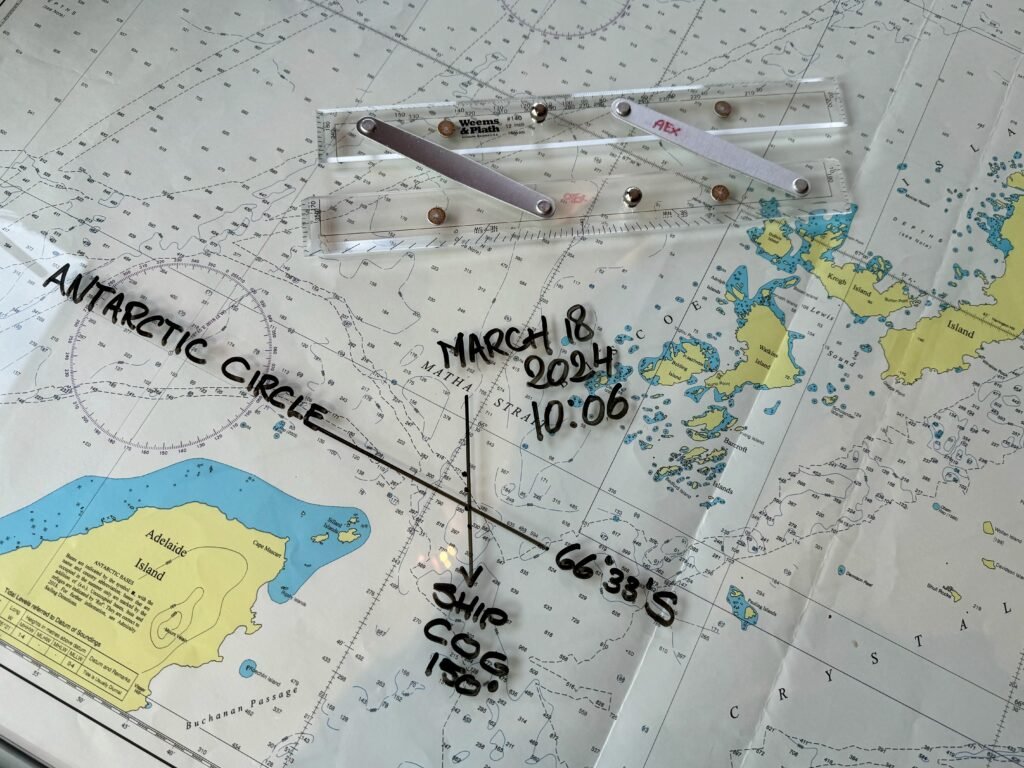
The map shows the coordinates of where we crossed the Antarctic Cricle. Photo by Jett Britnell
SOCIETY OF ANTARCTIC PLUNGERS
“I don’t go South of the Antarctic Circle often, but when I do, I jump in the water!”
—Mark Owens, Aurora Expeditions Circle & Weddell Sea Expedition Guest
“Cold shock! Your heart rate jumps. Stress hormones spike. You gasp suddenly and may hyperventilate” is, in a nutshell, how one unknown polar plunger described the legendary experience widely known as taking the Polar Plunge. A highly memorable and invigorating splash into the ocean experience that is typically offered once on every Antarctic expedition. During our trip, 39 guests out of a total of 75, along with three of the ship’s crew, ticked off a box on their bucket list after braving a splash into Antarctica’s frigid waters. It is during these moments of truth that experienced photographers can graciously decline the opportunity to make a polar plunge to photograph the proceedings for posterity.

Our new friend, Mark Owens, now has an Aurora Expeditions Antarctic Plunger certificate to forever remind him, “What was I thinking?”
CITIZEN SCIENCE
“By engaging in Citizen Science, we can truly create a positive impact for the places we visit and their future protection.”
—Marcos Goldin, Geologist & Citizen Science Coordinator, Aurora Expeditions
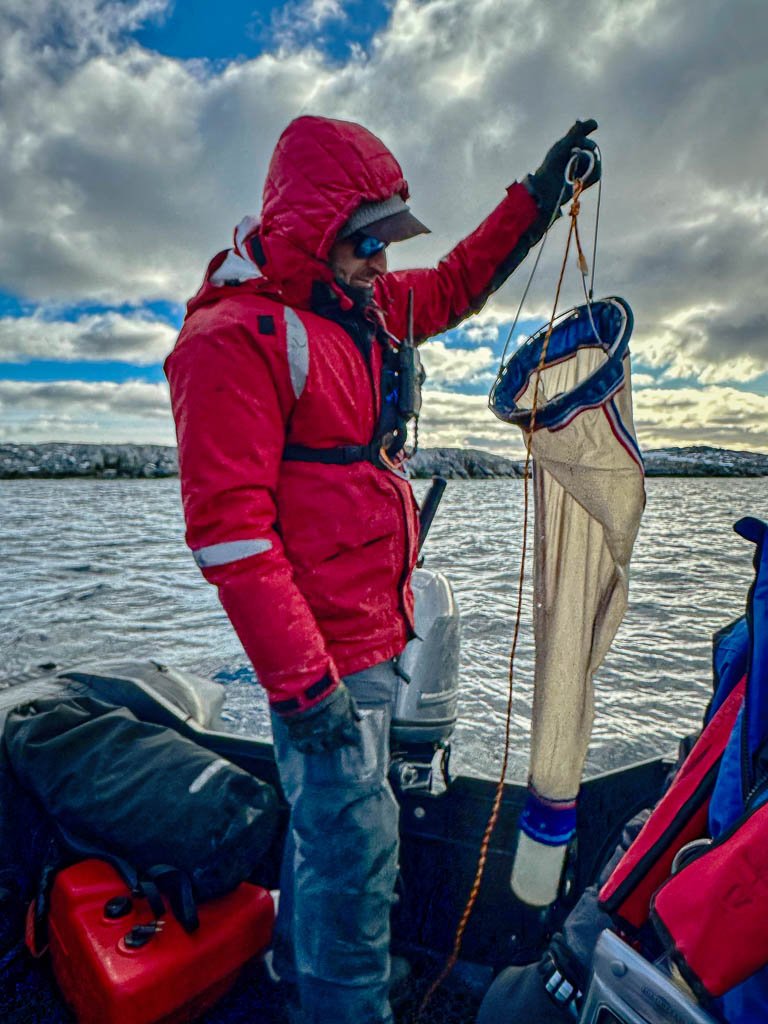
Marcos Goldin deploys a specialized net to strain the seawater to collect a concentrated sample of phytoplankton. Photo by Kathryn Britnell
Everyone is welcome to participate in a range of onboard Citizen Science projects. It’s important to note that the on-site data gathered from seabird surveys, cloud observations, penguin counts, collecting phytoplankton, identifying whales, and gathering data on Southern Ocean salinity and surface water temperatures contributes global scientific data to research projects being conducted by renowned academia and research institutions.
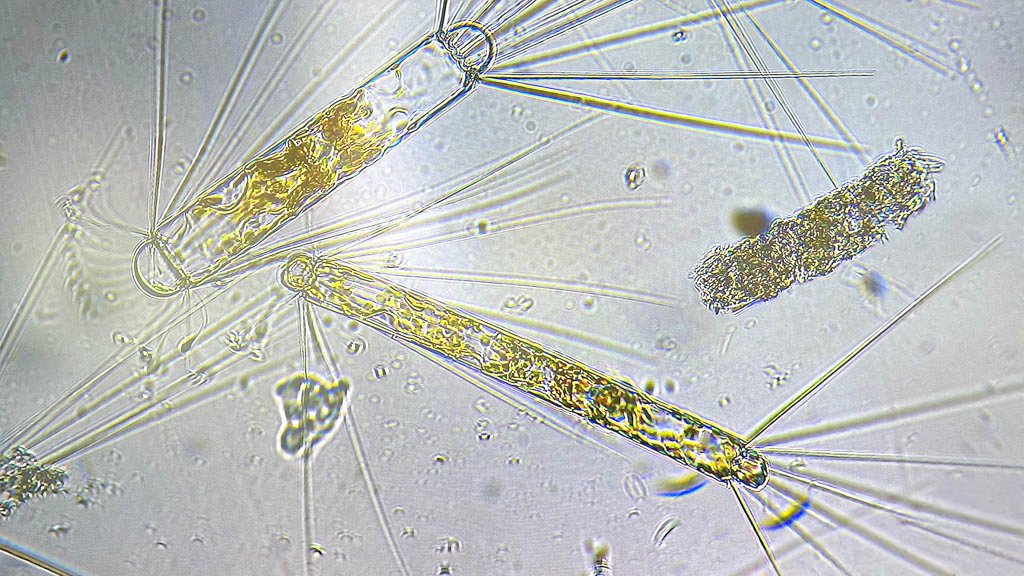
Phytoplankton are the base of the Antarctic food web. Photo by Kathryn Britnell
Surprisingly, we were drawn to collecting phytoplankton, so we boarded a Zodiac that was expressly going out to collect samples. This proved to be a highly interactive experience as our citizen science guide, Marcos Goldin, allowed all onboard to participate in specific tasks that needed to be performed to collect data.
ABANDONED RESEARCH STATIONS & HUTS
“For a joint scientific and geographical piece of organization, give me Scott; for a winter journey, Wilson; for a dash to the Pole and nothing else, Amundsen: and if I am in the devil of a hole and want to get out of it, give me Shackleton every time.”
—Captain Robert Falcon Scott, The first British explorer to reach the South Pole
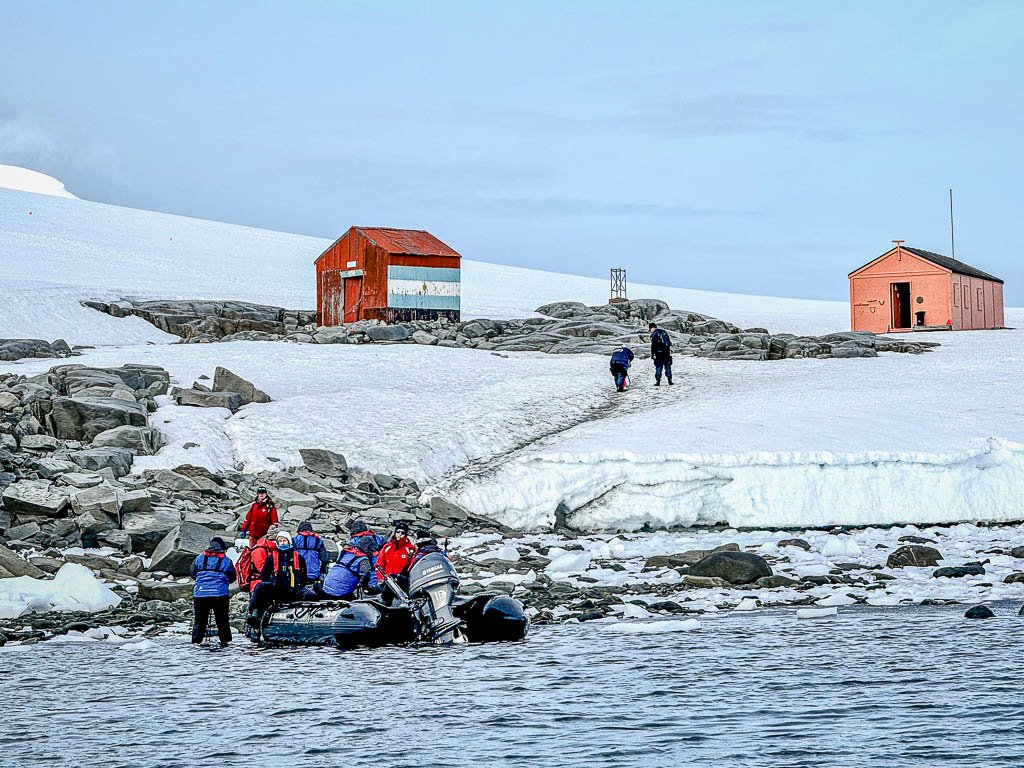
Damoy Hut at Dorian Bay is a special place listed as a Historic Site and Monument No. 84.This site is Antarctica’s only protected historic transit facility and skiway, providing shelter and safe passage for scientists. Photo by Jett Britnell
Since Antarctica’s discovery, many countries have established far off the beaten path research stations and bases peppered across the icy continent. While many of the stations were established under the auspices of conducting scientific research, the establishment of these stations was also made to stake territorial claims.
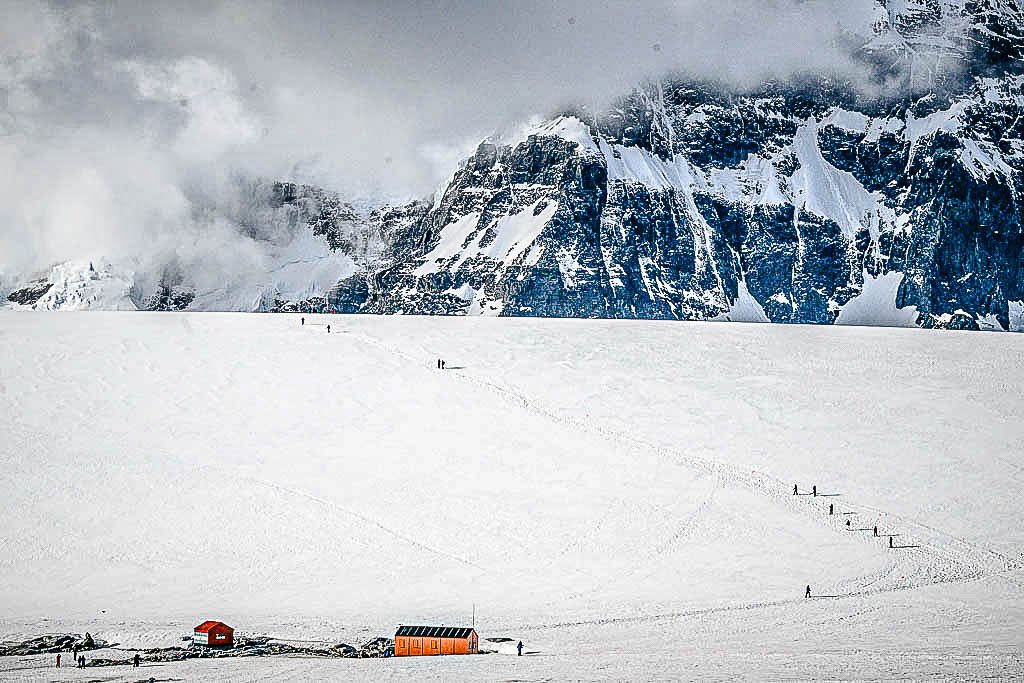
After viewing the Damoy Hut’s interior, expeditioners were allowed to roam freely about the site. Photo by Jett Britnell
While many abandoned Antarctic research stations and huts lie off the beaten path, many can be visited if shore conditions allow. In fact, many of these buildings are being preserved as museums. Shelves are still stocked with tins of canned goods and other remnants from the turn of the century that were left behind by their occupants. All provide a fascinating glimpse of past expeditions and former scientific research missions.
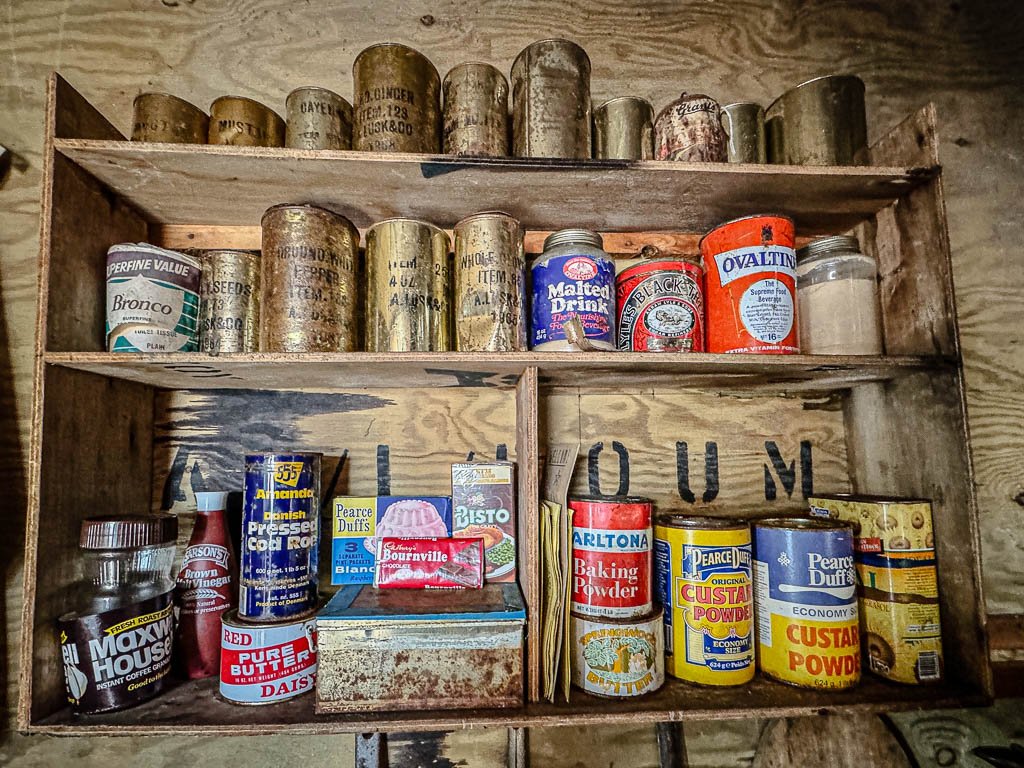
Damoy Hut has a wide array of canned goods on display. Photo by Jett Britnell
LIFTING THE VEIL ON ANTARCTIC PERILS
“The new threat of avian flu, in addition to warming temperatures and the highly concentrated nature of the krill fishery, could be catastrophic for the penguin colonies, other seabirds, and marine mammals found in the Antarctic Peninsula.”
— The Pew Charitable Trust
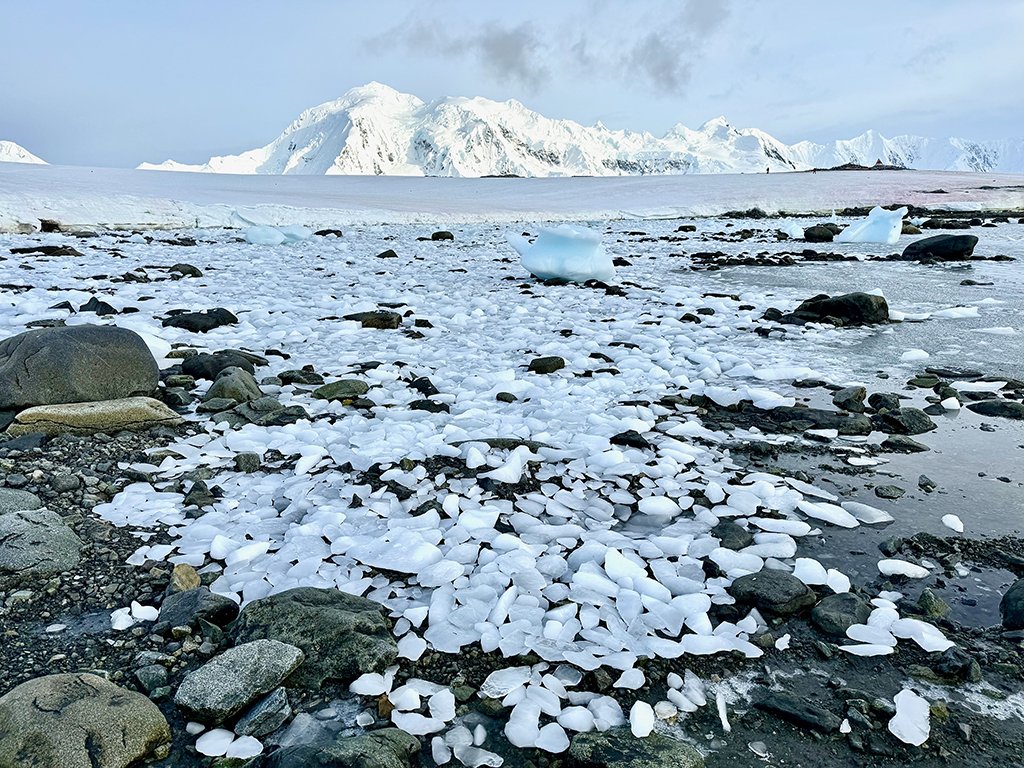
Antarctica is one of our planet’s most important biodiversity hotspots and ocean ecosystems. Photo by Jett Britnell
Antarctica is presently one of the most rapidly warming regions on Earth. This is indeed troubling since it is also one of our planet’s most important biodiversity hotspots and ocean ecosystems. The impacts of overfishing and human-induced global warming and climate change are both undeniable and unprecedented. According to a report from the Commission for the Conservation of Antarctic Marine Living Resources, Antarctic krill fishing has exponentially increased by 400 percent over the past two decades. Melting sea ice has had a measurable impact on where penguins establish colonies. Even green mosses are now experiencing a slightly longer growing season.
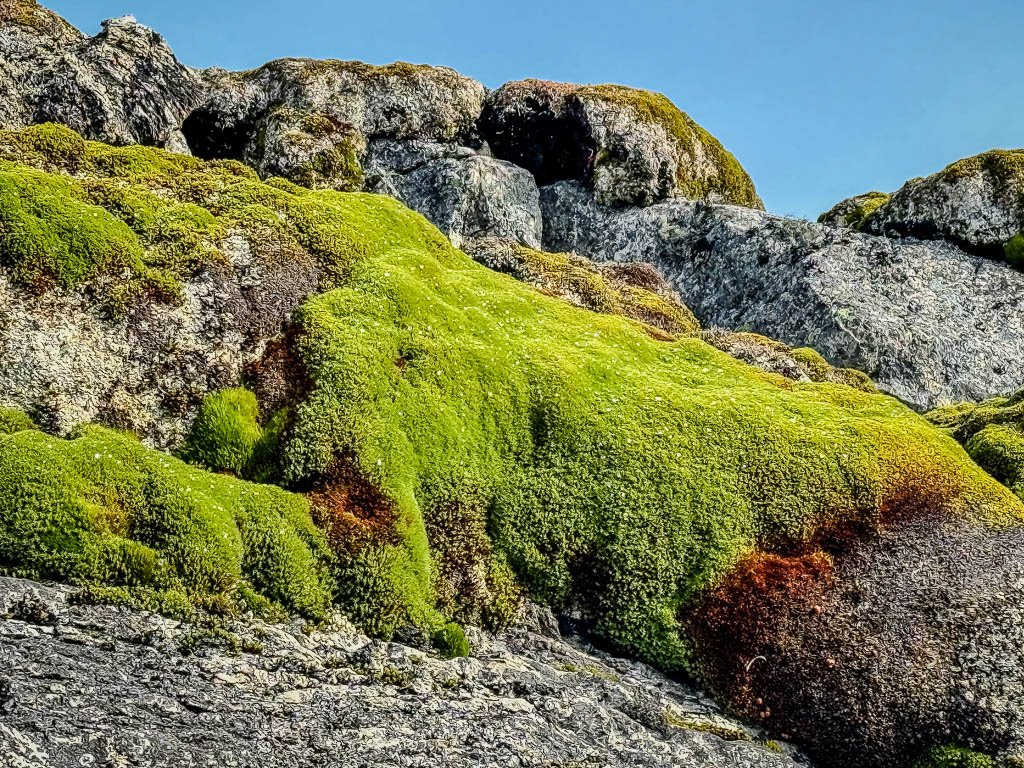
Mosses in Antarctica grow mostly in coastal areas and cope with the extreme conditions. Photo by Jett Britnell
In recent months, the highly contagious H5N1 influenza virus, also known as avian flu, has reached Antarctica’s shores. Scientists are fearful about the virus’s potentially devastating impact on the continent’s 48 bird species and 26 mammal species living in the region, often in dense colonies. Some of our planned shore landings were abruptly changed at some penguin colonies when it was discovered that many birds had presumably died from avian flu. Even some seal deaths have occurred. All observations of this nature are reported to the appropriate authorities, and access to these impacted penguin colonies is suspended until scientists can further investigate the exact cause.
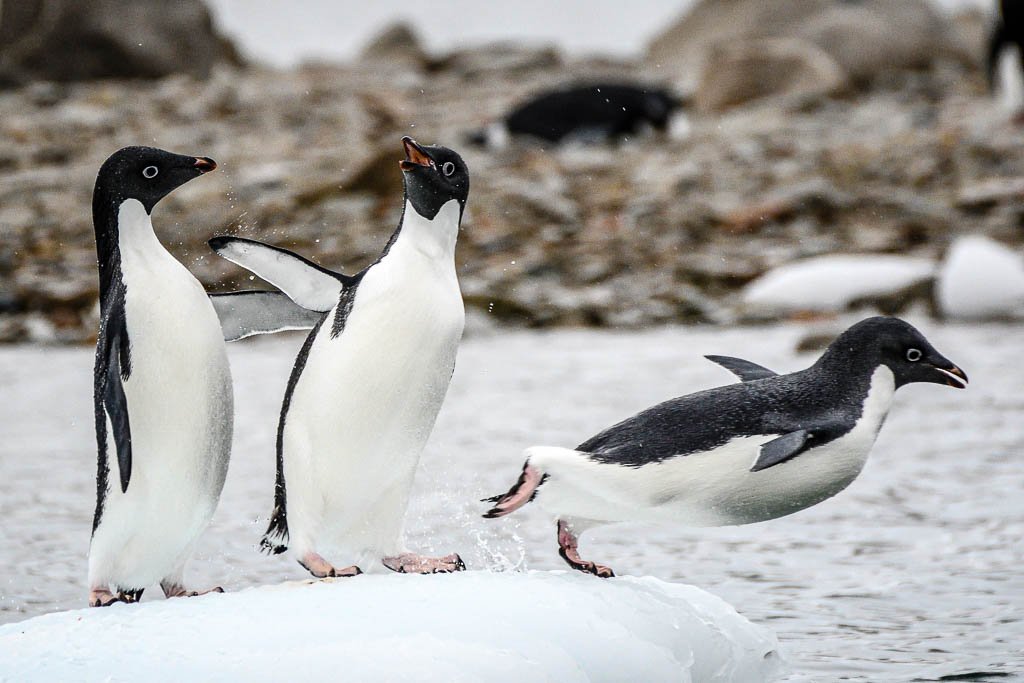
A scientific expedition in March 2024 found at least 532 dead Adélie penguins, with thousands more thought to have died. Researchers are trying to determine whether the birds died from avian bird flu. Photo by Kathryn Britnell
Enormous measures are undertaken by Aurora’s expedition team to prevent expeditioners from inadvertently carrying the avian flu virus from one shore site to another. Muck boots worn ashore are vigorously scrubbed before and after going ashore. Today, nobody is allowed to even kneel or place anything down on the ground. If someone were to slip and fall, their shore clothing must be scrubbed clean before they can go ashore again.
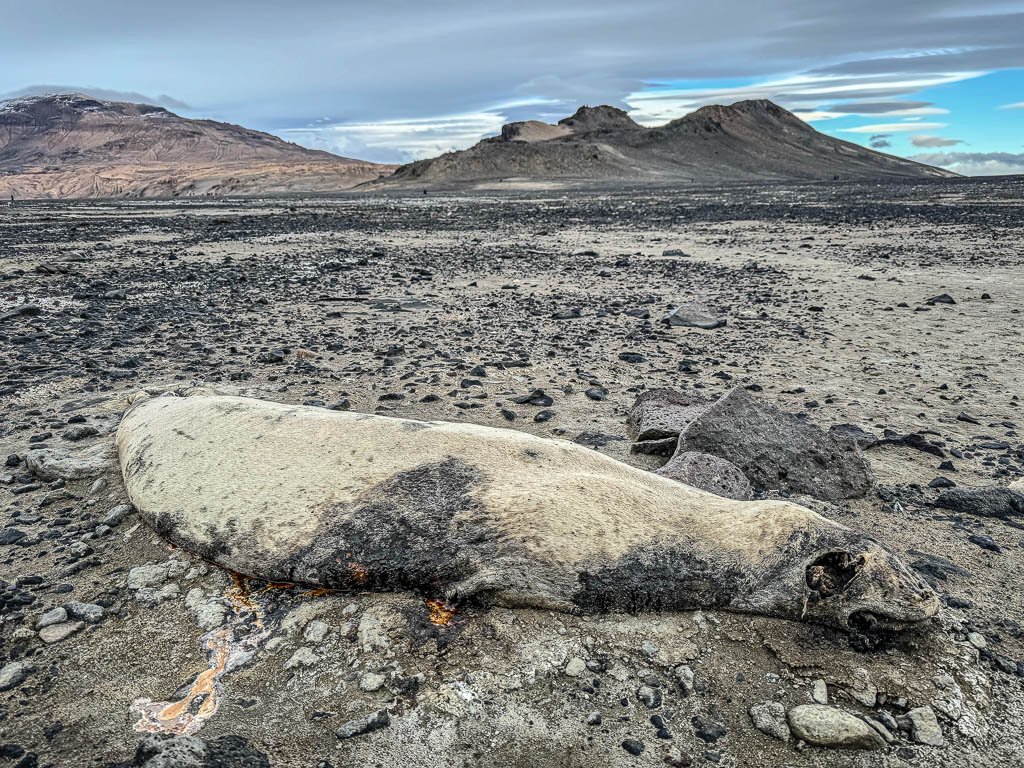
Far away from the beach front on The Naze Peninsula, we came across this seal carcass. We could not identify the species. While the avian flu is now known to have killed some seals, this seal may have died from natural causes. Hence the importance of scientific research in remote places. Photo by Jett Britnell
Some maintain that one simple solution is not to set foot there as the carbon footprint from air and sea travel fossil-fuel emissions merely accelerates ice melting. However, what is presently impacting Antarctica is reflective of a much larger global problem. However, for Antarctica, the news is not all grim, as The Polar Wildlife Report states recent studies suggest the extent of sea ice here has barely changed since 1979. Winter ice has slightly increased overall, while summer ice has slightly declined. A new sea ice predictive model acknowledged previous flaws and is now not predicting a future decline until 2050 at the earliest.
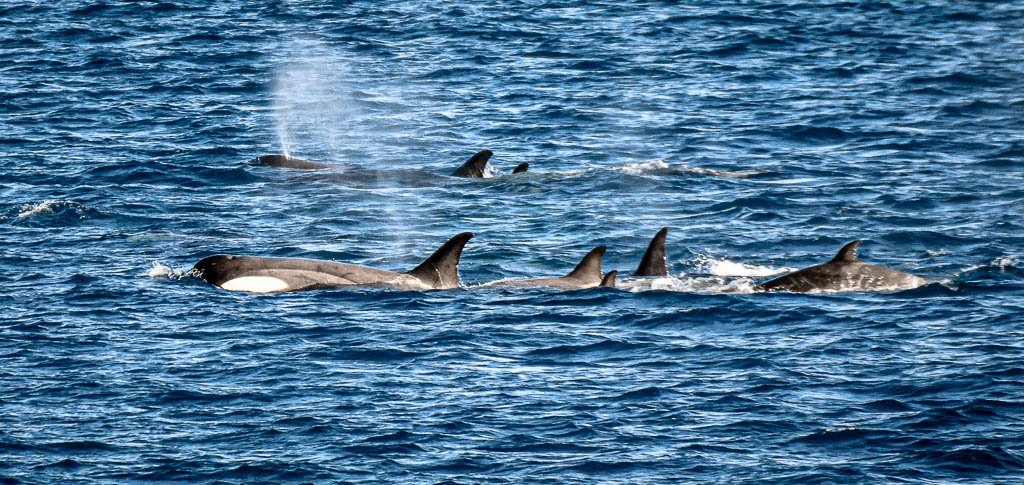
Orcas are demonstrating different responses to the changing conditions in the Southern Ocean. Two new found that orcas that rely on large expanses of sea ice to feed may be struggling to find enough food as climate change drives a decrease in annual ice cover, while those orcas that feed primarily in open water appear to be less affected. Photo by Kathryn Britnell
Many people believe that if you can help educate others and allow them to experience Antarctica firsthand, it may further compel them to protect what they love. After all, as Jacques-Yves Cousteau once said, “We only protect what we love, we only love what we understand, and we only understand what we are taught.” The threatening concern remains whether environmental impacts deteriorate much further, Antarctica may be shuttered altogether to ecotourism. In the meantime, the Weddell Sea region has been proposed as a potential climate refuge, or last sanctuary, for Antarctica’s ice-dependent and cold-adapted species to survive and thrive.

Flags have symbolically been unfurled in Antarctica since the first explorers set foot here. Kathryn Britnell FI’19, a Fellow International in The Explorers Club’s Canadian Chapter, is the first person to unfurl one of the Canadian Chapter’s expedition flags on the great white continent. The Explorers Club is an international organization dedicated to the advancement of field exploration and scientific inquiry.
BEYOND THE PALE OF CIVILIZATION
“Indeed, the stark polar lands grip the hearts of those who have been there in a manner that can hardly be understood by people who never got outside the pale of civilization”
— Sir Ernest Shackleton, Polar Explorer
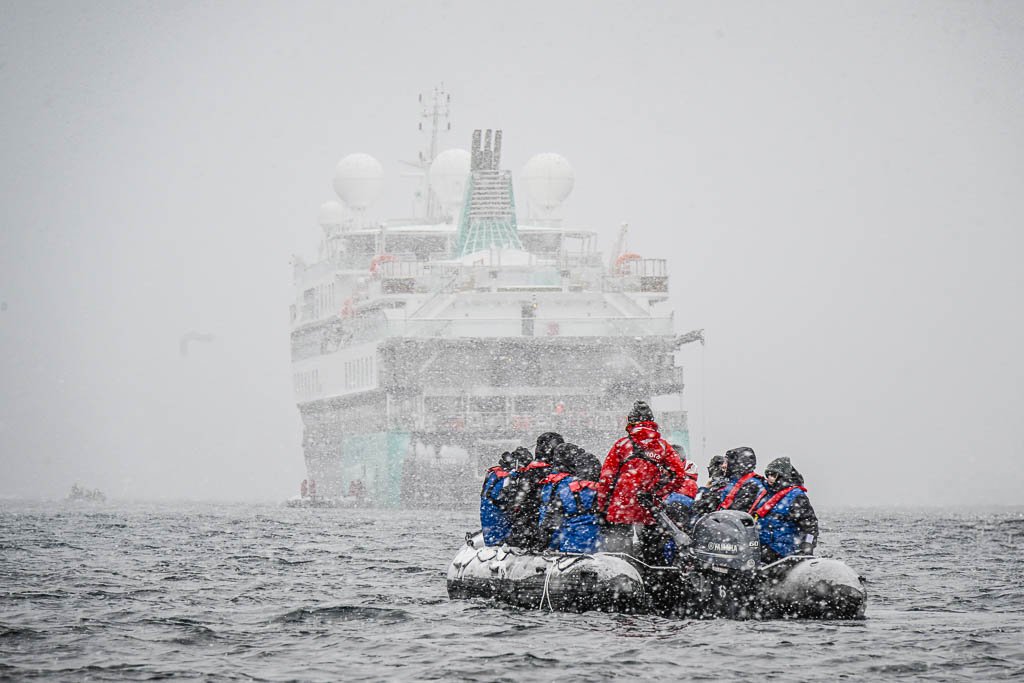
Snow Day in Antarctica! On our last Zodiac cruise at the end of our trip it snowed. It turned out to be our coldest day on the water.
Witnessing the white continents’ outlying isolation, rich diversity of wildlife, snow-shrouded topography, iconic icebergs, and the majestic coastal glaciers that fascinated intrepid explorers such as Shackleton, Amundsen, Scott, and Ross still leaves one lost for adequate words to describe Antarctica’s grandeur. As a truly wild continent that’s unlike anywhere else. It is a place that inspires wonderment, yet it remains a far-flung corner of the globe that many people will never see.

From sharing a life changing experience together new friendships are born. Group photo on the ship’s forward deck with expeditioners and Aurora’s talented Expedition Team. Photo by Scott Portelli
Sir David Attenborough succinctly described Antarctica as being… “A place where it’s possible to see the splendours and immensities of the natural world at its most dramatic and, what’s more, witness them almost exactly as they were, long, long before human beings ever arrived on the surface of this planet. Long may it remain so.”
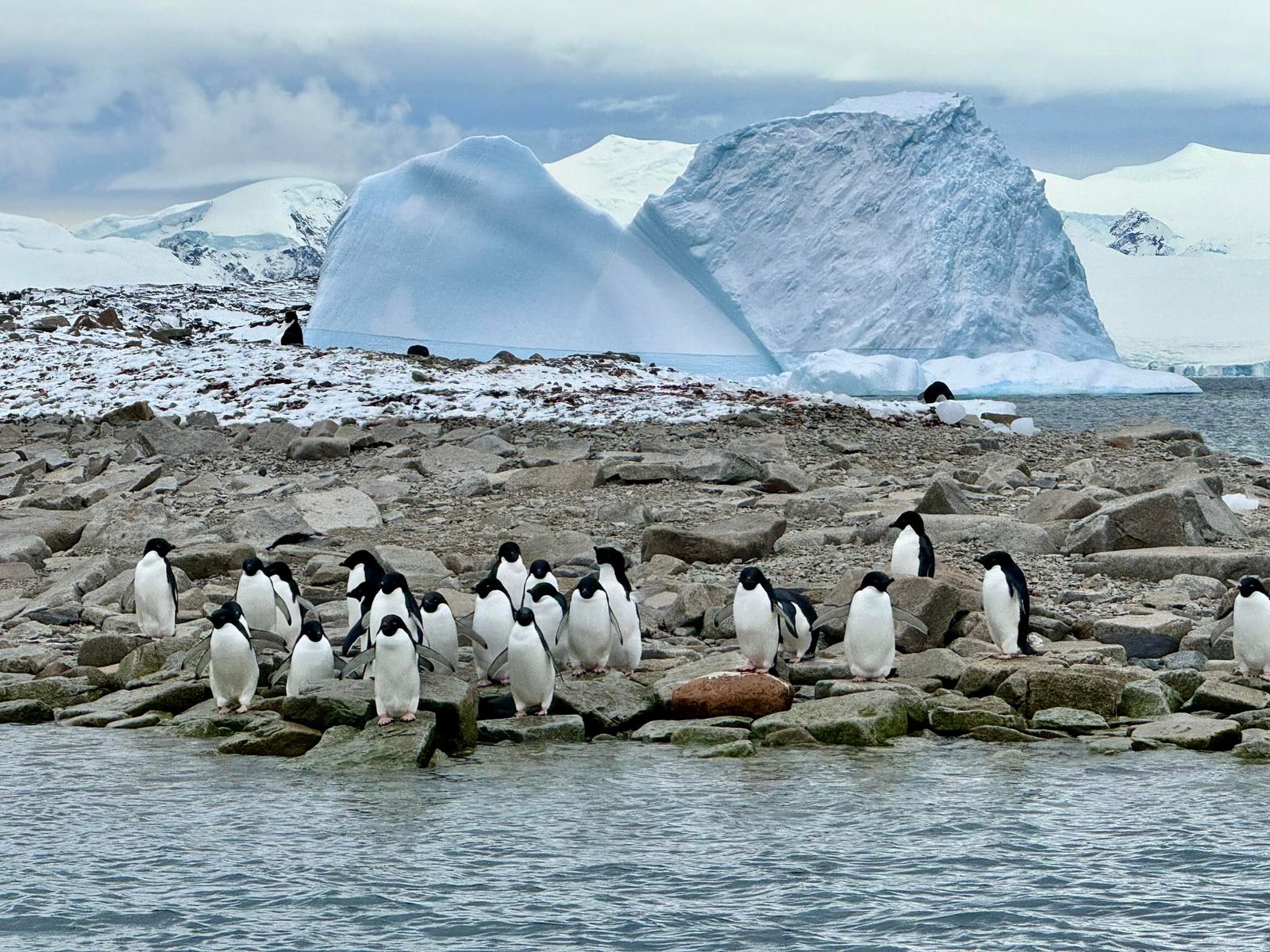
“These penguins call us to a deeper resolve and commitment to do what we can on their behalf. If we cannot save penguins—cannot save what everybody loves—what can we save?” ― Charles Bergman, Every Penguin in the World: A Quest to See Them All. Photo by Jett Britnell
Was our Antarctic adventure life changing? In a word, yes! How could anyone travel to the far southern fringes of the world and not feel changed? Question anyone who has been beyond the pale of civilization, and they will surely affirm that Antarctica is indeed life changing.
Until our next dispatch, dare to Explore…Dream…Discover.
EXPLORE THE WORLD’S WILDEST PLACES WITH AURORA EXPEDITIONS

For more than 33 years, Aurora Expeditions has been pioneering exploration and adventure, and they are deeply committed to travel with a positive impact. For more information about Antarctica small ship expeditions, visit: aurora-expeditions.com












